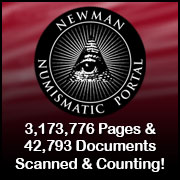
About UsThe Numismatic Bibliomania Society is a non-profit association devoted to the study and enjoyment of numismatic literature. For more information please see our web site at coinbooks.org SubscriptionsThose wishing to become new E-Sylum subscribers (or wishing to Unsubscribe) can go to the following web page link MembershipThere is a membership application available on the web site Membership Application To join, print the application and return it with your check to the address printed on the application. Print/Digital membership is $40 to addresses in the U.S., and $60 elsewhere. A digital-only membership is available for $25. For those without web access, write to: Charles Heck, Treasurer AsylumFor Asylum mailing address changes and other membership questions, contact Chuck at this email address: treasurer@coinbooks.org SubmissionsTo submit items for publication in The E-Sylum, write to the Editor at this address: whomren@gmail.com
BUY THE BOOK BEFORE THE COIN |
- WAYNE'S WORDS: THE E-SYLUM NOVEMBER 29, 2020
- MORE DAVIS DECEMBER 2020 SALE SELECTIONS
- SOLIDUS JANUARY 2021 LITERATURE SALE
- NEW BOOK: THE CONJUROR'S TRICK
- NEW BOOK: ZERO EURO SOUVENIR NOTES
- 2020 BNS NORTH BOOK PRIZE AWARDED
- GREGORY G. BRUNK (1949-2020)
- CLEMENT V. SCHETTINO (1953-2020)
- GOLD DUST IN OLD MINT COIN STORAGE BAGS
- VIDEO: A BILLION DOLLARS OF BEANIE BABIES
- COINS IN LUCITE
- IMITATION GUINEAS AND HALF-GUINEAS
- NOTES FROM E-SYLUM READERS: NOVEMBER 29, 2020
- NGC PHOTO PROOF HISTORY
- COLLECTING WHITMAN BOOKSHELF ALBUMS
- VOCABULARY TERM: OBSESSIVE DATE
- FRANK DEWETTE ANDREWS (1847-1937)
- JEFF BURKE'S NEW 1880-S MORGAN DOLLAR
- 2020 ANA RACHEL CARSON CONVENTION MEDAL
- ONLINE LECTURE: BANK NOTES AND SHINPLASTERS
- LYN KNIGHT DECEMBER 2020 AUCTION SELECTIONS
- ARCHIVES INTERNATIONAL AUCTION 63 SELECTIONS
- STACKS BOWERS DECEMBER 2020 AUCTION SELECTIONS
- ROMAN SILVER COINS FOUND IN SERBIA
- ADVENT COINS: A GAME OF THRONES
- DIX NOONAN WEBB OFFERS RON KERRIDGE TOKENS
- ROYAL SOCIETY MEMBER TICKET MEDALS OFFERED
- GARY ALLISS GOLFING MEDAL COLLECTION OFFERED
- DISNEY SECURITY'S UNOFFICIAL CHALLENGE COINS
- RUSSIA MAY VARNISH BANKNOTES
- ZIMBABWE DEALERS REPAIR WORN OUT DOLLARS
- LOCALIZED U.S. COIN SHORTAGES CONTINUE
- WHO WILL MISS THE COINS WHEN THEY'RE GONE?
- LOOSE CHANGE: NOVEMBER 29, 2020
- QUERY: NUMISMATIC MASKS?
- FEATURED WEB SITE: SRI LANKA BANKNOTES
Content presented in The E-Sylum is not necessarily researched or independently fact-checked, and views expressed do not necessarily represent those of the Numismatic Bibliomania Society.
WAYNE'S WORDS: THE E-SYLUM NOVEMBER 29, 2020
 New subscribers this week include:
Kurt Kelley, courtesy Tom Roberson;
Dr. Murphy Smith, courtesy Bo Cribbs; and
former ANA reader Benjamin Mous.
Welcome aboard! We now have 6,609 subscribers.
New subscribers this week include:
Kurt Kelley, courtesy Tom Roberson;
Dr. Murphy Smith, courtesy Bo Cribbs; and
former ANA reader Benjamin Mous.
Welcome aboard! We now have 6,609 subscribers.
Thank you for reading The E-Sylum. If you enjoy it, please send me the email addresses of friends you think may enjoy it as well and I'll send them a subscription. Contact me at whomren@gmail.com anytime regarding your subscription, or questions, comments or suggestions about our content.
This week we open with two numismatic literature sales, two new books, two obituaries, a book prize, updates from the Newman Numismatic Portal, and more.
Other topics this week include Zero Euro notes, U.S. Mint coin storage bags, imitation guineas, NGC Photo Proof, coins in Lucite, Whitman bookshelf albums, obsessive dates, Frank Andrews, Rachel Carson, multiple auction selections, Advent coins, Royal Society member ticket medals, worn out dollars, coin shortages and numismatic masks.
To learn more about paper money of India, the Iron Age old coinage of southern England, countermarked coins, sweating gold, numismatic cats, General Butler's Colored Troops medal, the Cohen Mint, the Jewish People's Bank of Harbin, China, the gold dollar Love Token bracelet, unofficial Disney Security challenge coins, Greenback Chase and a billion dollars worth of Beanie Babies, read on. Have a great week, everyone!
Wayne Homren
Editor, The E-Sylum
MORE DAVIS DECEMBER 2020 SALE SELECTIONS
Charlie Davis submitted this note with additional highlights of this week's numismatic literature sale. Great opportunity to pick up some nice rarities. -Editor
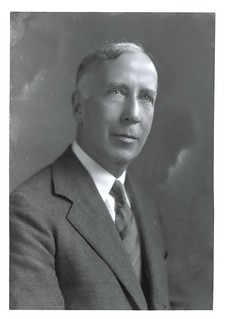 Our auction sale offering unique books and ephemera, American and British, from the libraries of Dave Bowers, Ted Natfzger and Howard Newcomb closes this coming Saturday, December 5. Those who have not received a catalogue may visit the on-line version at
Numisbook.com. All lots are illustrated on our alternate site
Charlesdavisnumismatics.com.
Our auction sale offering unique books and ephemera, American and British, from the libraries of Dave Bowers, Ted Natfzger and Howard Newcomb closes this coming Saturday, December 5. Those who have not received a catalogue may visit the on-line version at
Numisbook.com. All lots are illustrated on our alternate site
Charlesdavisnumismatics.com.
Newcomb's fine studio portrait, while not included in the sale, has been reproduced on each lot card.
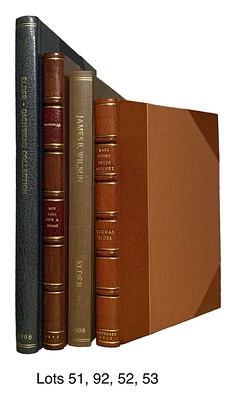
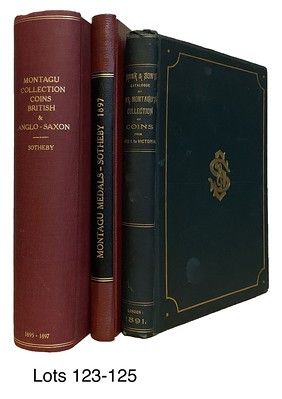
Lots 51-53, 92, 123-125
Plated catalogues including Gschwend, Wilson, Mougey and Parmelee
The Montagu Collection of British coins, medals, patterns, complete in three volumes
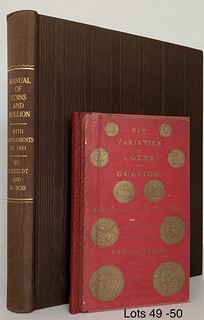
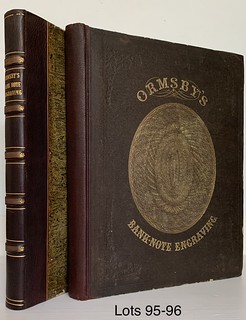
Lots 49, 50, 95, 96
Two versions of Eckfeldt & Dubois Mint Manuals, one with the gold samples
Two copies of Ormsby's System of Engraving
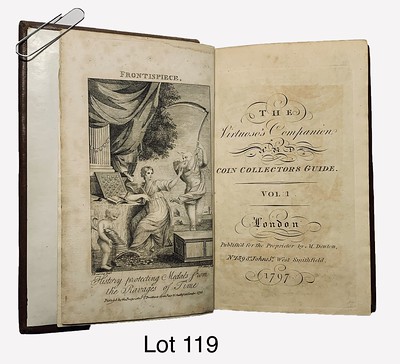
Lot 119: The Virtuoso's Companion, complete in 8 parts.
To read the earlier E-Sylum articles, see:
CHARLES DAVIS DECEMBER 2020 SALE SELECTIONS
(https://www.coinbooks.org/v23/esylum_v23n42a03.html)
CHARLES DAVIS DECEMBER 2020 SALE HIGHLIGHTS
(https://www.coinbooks.org/v23/esylum_v23n47a02.html)

SOLIDUS JANUARY 2021 LITERATURE SALE
Literature Auction 69 by Solidus of Munich contains numerous rarities from the 17th to the 19th century, among others from the library of Reinhold Jordan, as well as current, out of print and rare specialist literature, including duplicates from the library of Ursula Kampmann. Here are a few selected lots. -Editor
Selected numismatic literature with many rarities and bibliophilic treasures of the 17th and 18th century including large quantities of the libraries of Ursula Kampmann and Reinhold Jordan - furthermore some numismatic graphics and publications concerning archeology and history
Lot 1
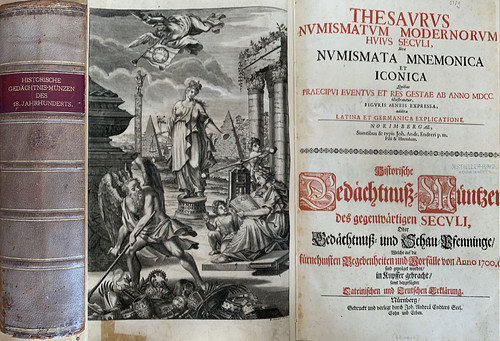
Monographs. Bibliophile works. Anonymous.
Thesaurus Numismatum Modernum Huius Seculi. Historical commemorative coins of the current Seculi. Lat. et Germ. cum Supplementus et Indicibus 1700 - 1709. Volumes 1 - 4. Nuremberg 1700 - 1716. 238 p .; Pp. 239-554; Pp. 555-873; Pp. 875-969; Pp. 971 - 1097, 1 double copperplate, index. Each with many copper images. Tied in a ribbon. Half leather, corners bumped, contents flawless.
With owner's stamp and owner's note. Rare work. Price achieved in Künker auction no. 169 (June 2010): 6,000.
Lot 8
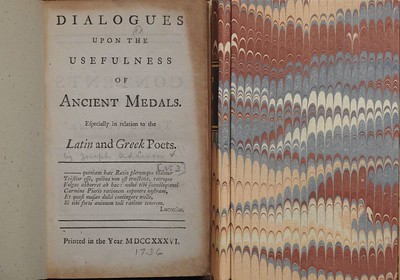
Monographs. Bibliophile works. Addison, J.
Dialogues upon the usefulness of ancient medals. Especially in relation to the Latin and Greek Poets. Without location 1736. 235 p., Including 31 pl. Newer cardboard tape.
Very rare.
Lot 9
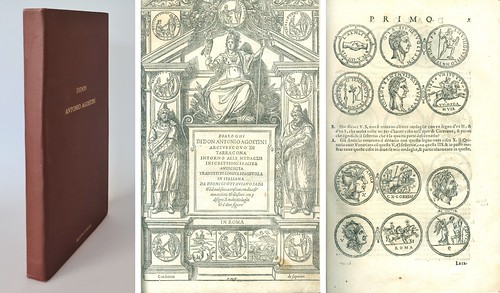
Monographs. Bibliophile works. Agostini, A.
Dialoghi di Don Antonio Agostini Arcivescovo di Tarracona intorno alle medaglie inscrittioni et altre antichita. Rome 1592. 5 sheets, 300 p. With many coin woodcuts in the text, register. Newer all linen, somewhat foxed and browned on the sides.
With bookplate Reinhold Jordan.
Lot 17
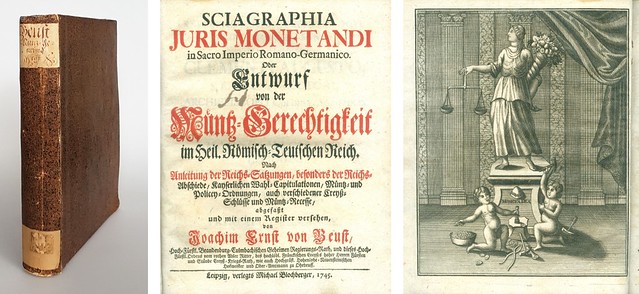
Monographs. Bibliophile works. Beust, JE from.
Sciagraphia iuris monetandi in Sacro Imperio Romano-Germanico, or draft of the Müntz justice in salvation. Roman-Teutonic Empire: according to the instructions of the imperial statutes, especially the imperial farewells, imperial election capitulations, coin and policy regulations, also various Kreyß conclusions and coin recesses. Leipzig 1745. 12 sheets, 362 pages, several pages of appendix and register. Cardboard tape.
Very rare work.
Lot 24
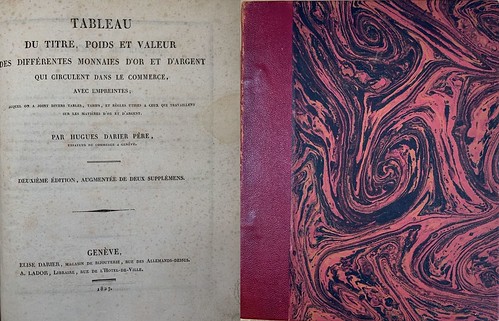
Monographs. Bibliophile works. Darier, H.
Tableau du titre, poids et valeur des différentes monnaies dor et dargent qui circulent dans le commerce, avec empreintes, auquel on a joint divers tables, tarifs, et règles utiles a ceux qui travaillent sur les matièresdor et dargent. Geneva 1827. 4 pp., 78 pp., 66 Tfn. Half leather, endpapers renewed, somewhat foxed.
Lot 62
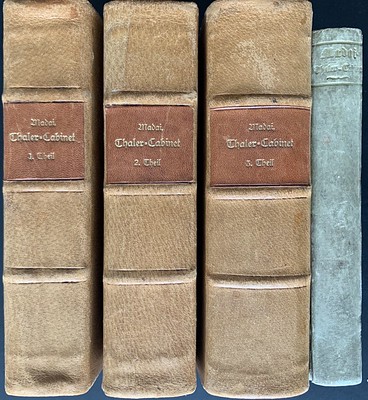
Monographs. Bibliophile works. Madai, DS of.
Complete Thaler cabinet. Considerably increased again. 3 parts and 3 continuations in a total of 4 volumes. Königsberg, Hartungs Erben and Zeise (Vol. III and cont. I and II: Zeisen's widow and Hartung's heirs; cont. III: Königsberg and Leipzig, Hartung), 1765-74. Engraved with 3. Frontisp., 6 engraved. Title vign. and 12 engraved. Head vign. Full leather and half parchment.
With bookplate Hermann Wintz.
Lot 94
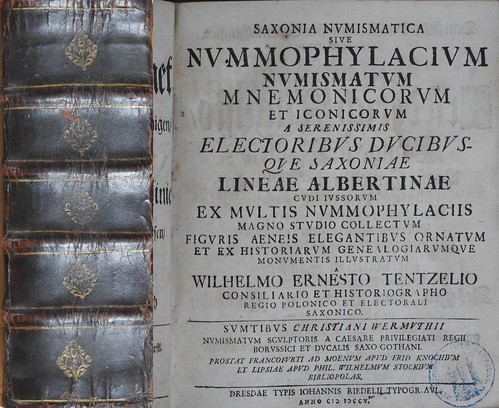
Monographs. Bibliophile works. Tentzel, WE
Saxonia Numismatica or medal cabinet of Gedächtniß-Müntzen and display pfennigs, which the Chur and Princes of Saxony had the Albertinian main line stamped and manufactured. 4 parts in 1 volume. Dresden 1705. With gest. Front. u. 95 copper plate 16 leaves, 744 p., 1 leaf, p. 521-658 (see above), 56 leaves Register. Full leather.
With library stamp.
For more information, or to bid, see:
Literature Auction 69 - 03.01.2021 10:00
(https://solidus-numismatik.auex.de/Auktion/Onlinekatalog?intAuktionsId=993)

NEW BOOK: THE CONJUROR'S TRICK
A new book has been published on the history of paper money of India. -Editor
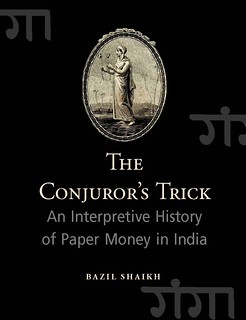 Title : The Conjuror's Trick: An Interpretative History of Paper Money in India (Paperback)
Title : The Conjuror's Trick: An Interpretative History of Paper Money in India (Paperback)
Author : Bazil Shaikh
Year : 2020
When banks issued notes that circulated as money, they conjured money out of thin air, introducing the unique alchemy in money's transition from the concrete to the abstract. Straddling perspectives of finance, history, public policy and art, this book explores the diversity, purpose and legacy of paper money, as it evolved in India from the late 18th century to the present.
For more information, or to order, see:
PREVIEW NOW
SHARE
The Conjuror's Trick: An Interpretative History of Paper Money in India
(https://www.bagchee.com/books/BB131607/the-conjurors-trick-an-interpretative-history-of-paper-money-in-india)
The Conjuror's Trick: An Interpretative History of Paper Money in India (Paperback)
(https://ompublications.in/product/books/OM47923)
NEW BOOK: ZERO EURO SOUVENIR NOTES
Hans-Ludwig Grabowski has published a catalog of zero Euro souvenir banknotes. Here's a Google-translated article from Geldscheine Online. -Editor
Grabowski: Catalog of the zero euro souvenir notes
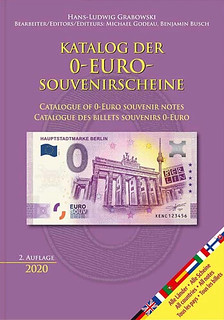 Hans-Ludwig Grabowski
Hans-Ludwig Grabowski
(Michael Godeau, Benjamin Busch):
Catalog of the 0 euro souvenir notes
624 pages, color illustrations throughout, format 14.8 cm x 21 cm, paperback, 2nd edition, Regenstauf 2020,
ISBN 978-3-86646-195-6 .
Price: 29.90 euros
All editions of all countries!
- Over 2000 different motifs!
- Introduction in nine languages!
- With language-neutral catalog section!
- With index of all issues!
- With current ratings in euros!
Available from November 12th, 2020!
The collecting area for 0 euro souvenir notes is celebrating its fifth birthday this year and the phenomenon has spread enormously since the first edition of this catalog. Of course, this second edition also includes all editions of all countries that were known by the editorial deadline (end of September 2020), shown in color and rated, with information on the editions and the various security threads.
While the first edition of the collector's catalog from 2018 included around 700 motifs, there are now over 2000 motifs for the popular euro souvenir notes.
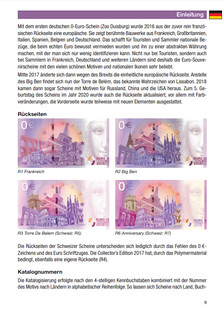
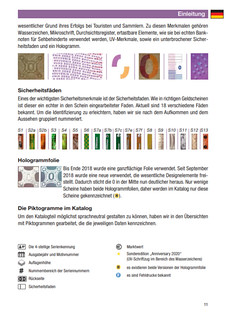
Since the first edition of the catalog has already developed into a standard work, the completely revised second edition is now appearing with all currently issued motifs in a larger format and with a language-neutral catalog section that can easily be used by all collectors in different countries.
In order to reach an even larger number of collectors directly, all important information is included in the introduction in German, English, French, Portuguese, Spanish, Dutch, Italian, Finnish and Slovak.
Edited by Michael Godeau and Benjamin Busch.
Found via News & Notes from the Society of Paper Money Collectors (Volume VI, Number 22, November 17, 2020). -Editor
To read the complete article, see:
Grabowski: Katalog der 0-Euro-Souvenirscheine
(https://www.geldscheine-online.com/post/grabowski-katalog-der-0-euro-souvenirscheine)
To read earlier E-Sylum articles, see:
THE ZERO EURO BANKNOTE
(https://www.coinbooks.org/esylum_v19n32a28.html)
TURKEY'S GÖBEKLITEPE COMMEMORATIVE ZERO EURO
(https://www.coinbooks.org/v22/esylum_v22n20a30.html)
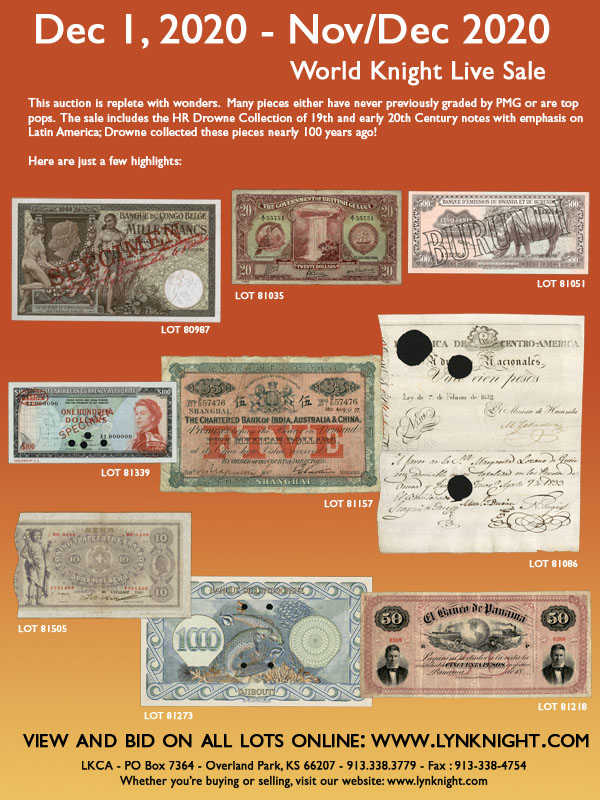
2020 BNS NORTH BOOK PRIZE AWARDED
A press release issued by the publisher Chris Rudd announces the awarding of the British Numismatic Society's 2020 North Book Prize to author Dr John Sills for his 2017 work, Divided Kingdoms: the Iron Age old coinage of southern England. Great photo of Dr Sills with his book. We TOLD you it's big... -Editor
Grimsby scholar scoops top book prize
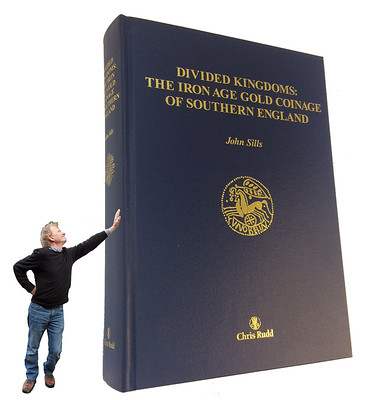 Dr John Sills, the Celtic numismatist from Grimsby, north Lincolnshire, has won a premier book prize. The council of the British Numismatic Society has recently awarded him the 2020 North Book Prize worth £500 for his 'monumental' 825-page Divided Kingdoms: the Iron Age old coinage of southern England published by Chris Rudd in 2017. Described as "astonishing" by fellow numismatist Dr Philip de Jersey and "brilliant" by archaeologist Professor Sir Barry Cunliffe, Divided Kingdoms was judged the winner out of "no less than 17 titles published over the last four years".
Dr John Sills, the Celtic numismatist from Grimsby, north Lincolnshire, has won a premier book prize. The council of the British Numismatic Society has recently awarded him the 2020 North Book Prize worth £500 for his 'monumental' 825-page Divided Kingdoms: the Iron Age old coinage of southern England published by Chris Rudd in 2017. Described as "astonishing" by fellow numismatist Dr Philip de Jersey and "brilliant" by archaeologist Professor Sir Barry Cunliffe, Divided Kingdoms was judged the winner out of "no less than 17 titles published over the last four years".
Commenting on his award Dr Sills says:
"I am delighted and honoured. This book took me ten years to research and write and, despite the fact that it weighs 8lbs and costs £95, has proved surprisingly popular with collectors and students of British Iron Age coins".
Elizabeth Cottam, director of Chris Rudd Ltd says:
"A unique work of reference will always sell well if it meets a need, if it's comprehensive and authoritative, and if it's well illustrated. John's Divided Kingdoms catalogues more than 10,000 Celtic gold coins of the southern, north Thames and Kent regions, is the first book that pulls together the past 50 years of coin finds to reconstruct the lost political history of southern Britain between Caesar and Claudius, and illustrates 600 of the coins with twice-size photos. I'm thrilled that Divided Kingdoms has been publicly acclaimed by the British Numismatic Society. In 2018 it was highly commended in the competition for the prestigious IAPN Book Prize."
For more information, or to order, see:
Divided Kingdoms: the Iron Age gold coinage of southern England
(https://celticcoins.com/shop/books/divided-kingdoms-the-iron-age-gold-coinage-of-southern-england/)

GREGORY G. BRUNK (1949-2020)
Jeff Kelley of Massachusetts writes:
"I just saw the news that Dr. Gregory Brunk passed away in October.
"It is of course a great loss for his family and friends, but also for so many of us who benefitted from his tireless research and cataloging in the area of counterstamps/countermarks.
"I understand that he had plans to publish a new edition of his book but that was interrupted by the untimely passing of his publisher Rich Hartzog three years ago.
"I can only hope that his important work is not lost during the difficult task of settling his estate. I have no idea to what extent his heirs were involved in his publishing activities."
Dick Grinolds, Len Augsburger and others passed along this news. Dr. Brunk was the primary expert in the field of merchant counterstamps, an area I collected myself for many years.
Below is an excerpt from his online obituary. So far no one seems to have heard from his family about the disposition of his research and manuscripts. Len and I had been in touch with Brunk indirectly via Bill Groom hoping to publish online updates to his works on the Newman Numismatic Portal, but nothing had come to pass. -Editor
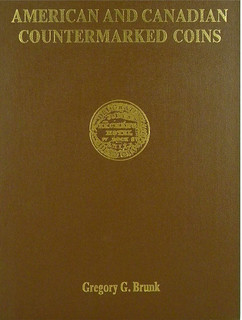
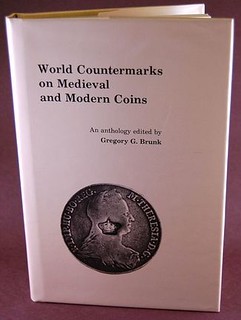
 Gregory G. Brunk, 71, of Waterloo died Monday, Oct 19, at Unity Point Allen Hospital.
Gregory G. Brunk, 71, of Waterloo died Monday, Oct 19, at Unity Point Allen Hospital.
He was born Aug. 28, 1949, in Waterloo, the son of W. Summerfield and Berenice Seaman Brunk, who preceded him in death.
A 1967 graduate of Orange High School, he began his career in academia at Drake University, from which he graduated with honors in history and political science. He received his master's degree in history from the University of Illinois, a master's in economics from the University of Iowa, where he was a Fairall Scholar, and a Ph.D. in political science from Iowa.
He taught at the University of Alabama and the University of Oklahoma, and published more than 100 articles, book chapters and research notes in a variety of disciplines. He also wrote or co-authored six books, including "Understanding Attitudes About War: Modeling Moral Judgements" and "Theories of Political Processes." His works appeared in many academic publications, including the American Journal of Political Science, American Politics Quarterly and the British Journal of Political Science.
He also wrote extensively about numismatics, a lifetime passion, was a Fellow of the Royal Numismatic Society and the Canadian Numismatic Research Society, and received many awards from both bodies. He catalogued ancient coins for auction for several decades, and was often called upon to evaluate unusual coins, medals and tokens.
After retiring from academia, he lived a quiet life, dedicating himself to research in his fields of expertise.
To read the complete obituary, see:
Gregory G. Brunk
(https://www.lockefuneralhome.com/obituaries/gregory-g.-brunk)
CLEMENT V. SCHETTINO (1953-2020)
Mike Wierzba submitted this remembrance of his friend Clem Schettino. Sorry to hear the news. -Editor
It was with great sadness that I learned on Thanksgiving Day the passing of my dear friend, numismatist Clem Schettino. With so many great memories of our adventures together, I struggled, wondering how I could even begin to explain the impact Clem had on my, and so many others', lives. And as it sometimes happens, and only with the truly great friends, your mourning is interrupted by laughter when you find yourself reliving the friendship from the very beginning...
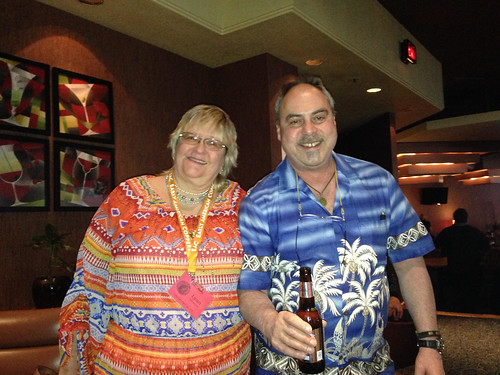
Lynn and Clem Schettino
We were at the Cincinnati EAC Convention and those who attended will remember the "interesting" hotel in Kentucky (not Ohio) designed like a castle. The party didn't end after the Thursday night EAC reception, and Clem was on a mission to drain every last drop of leftover beer from the kegs. Clem scoured the near-empty room for anything, and anyone, to save the beer. He filled five pitchers to the absolute brim and handed me, a 15-year-old kid, two. We tiptoed through the hotel halls trying not to draw attention but laughing way too hard and certainly too loud as Clem tried to balance three full pitchers of beer. Then, a security guard wisely informed us that I, a minor, probably shouldn't be helping appropriate alcohol. Undeterred, Clem continued onward, now sloppily carrying all five pitchers, sloshing beer all over himself as he pushed forward. Lesser men would have made two trips, but Clem began belting 'Sunday Bloody Sunday' at the top of his lungs in defiance, arriving at his hotel room a hero to the small, but thirsty, after-convention party he'd invited. That was the beginning of our great friendship, but the end of kegs at EAC Conventions.
Clem was a founding member of C4, at that time specializing in New Jersey Coppers, Fugios, and several other colonial series. Many people may not know that during the first C4 Convention auction, the Fugio collection (auctioned after John Griffee's NJ coppers) was Clem's.
In the years to follow, Clem became a pioneer in the study of British and Irish counterfeit halfpennies and farthings, undertaking early serious work on creating a collecting system for these understudied pieces. Anyone who understood Clem as a collector realized that when he started researching a new series, he went ALL the way. Clem's larger-than-life personality belied a highly organized collector with endless enthusiasm for research. During his study, Clem amassed one of the finest collections ever assembled, discovering and obtaining many new and unique varieties, and acquired thousands of pieces.
Clem had three standout priorities in his life, coins coming in a distant third. First and foremost, he was a dedicated family man. He absolutely adored his loving wife Lynn and his sons Alex and Angelo, and they were often by his side at coin shows across the country. Second to that, his friends and the coin community.
Clem truly loved coin conventions and was always excited and happy before a show, knowing he would soon be right in his element. If you needed him afterward, you knew to check the hotel lounge, where he would be celebrating the day, taking upon himself the responsibility to ensure everyone around him was having the best time they could possibly have. Clem loved life and had a way of bringing a smile to everyone's face, telling jokes (some even at his own expense), stories, or reassuring someone for the second time in twenty minutes that he loved the new coin they just bought. Nobody cared more about his fellow collectors than Clem, and he is responsible for happily mentoring and inspiring many C4 members active today. He was generous and delighted to share his knowledge and welcomed anyone that shared the passion - even me as a lost teenager that night at the Cincinnati EAC Convention when he readily adopted me into a community that has since defined my life. Clem was my loyal and passionate friend who never had a bad thing to say about anyone he cared about which is one of the best qualities I learned from him.
Clem left us with many stories I would love to include here, which would take up hundreds of pages, and all of them are worthy of print. But, almost all C4 and EAC members have a story, or a dozen, to tell because everyone who spent time with Clem emerged a better collector and a better person. His name and memory will never be forgotten in the collecting circles, and I look forward to future nights at the lounge after a long day on the bourse, going around the room, sharing stories and memories of Clem for many years to come. Rest in peace my friend, you are remembered dearly for taking coins and your dedication to your family seriously, but wisely not taking life too seriously, enjoying all it had to offer and thus, shaping all of us for the better.
Clem had some webpages on Geocities, an early web publishing platform. -Editor
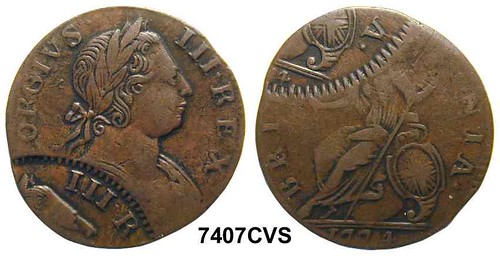
1774 double struck counterfeit British 1/2d
Hello, I am a collector and part time dealer of Early American Coins. I live in Massachusetts, just north of Boston in what's called "the north shore". I deal primarily with Colonial and Early US coins. Especially the state issues from 1785 to 1788. I collect the coins of New Jersey, dated 1786 to 1788. I have been collecting this series for well over a decade and still maintain my collection. Because of the fact that these have become rather scarce and quite expensive and I'm now finding it very difficult to add new varieties or even make upgrades, I have therefore been gravitating toward collecting and researching Contemporary Counterfeit British Halfpence and Farthings, and to some degree counterfeit Irish as well. These coins circulated extensively here during our colonial period.
To read the complete article, see:
Clement V. Schettino DBA CVS Rare Coins
(http://www.geocities.ws/copperclem/)

GOLD DUST IN OLD MINT COIN STORAGE BAGS
Newman Numismatic Portal Project Coordinator Len Augsburger provided the following report on some interesting U.S. Mint correspondence concerning valuable gold dust in old coin storage bags. -Editor
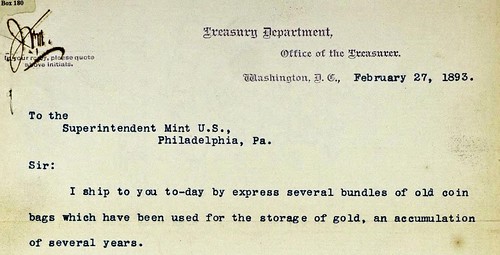
U.S. Mint Sweats Gold
An old (and fraudulent) trick in the gold business is to vigorously shake a bag of gold coins together, in an effort to free a few bits of the previous metal in the form of dust, which can be sold to the benefit of the owner. The devalued coins still retain their face value, so there is no loss in that regard. This is known as "sweating" gold. The U.S. Treasury engaged in the same practice, though to be sure not on a deliberate basis.
An 1893 letter from the U.S. Treasurer to the Superintendent of the Philadelphia Mint (Oliver C. Bosbyshell) notes that bags used to store gold coins contained measurable amount of gold dust. Two bags are noted in this correspondence, one yielding 2.87 grains of gold and the other 2.16 grains (worth 12.3 cents and 9.3 cents respectively). Enos H. Nebecker, the U.S. Treasurer, notes a number of coin bags from the New York assay office had been forwarded to the Mint for harvesting the remaining gold. Presumably the number of bags was large, as the shipping costs from New York to Philadelphia would have offset any profit.
What the government took with one hand it gave back with the other. Congress made appropriations to make the country's circulating coinage whole, so that if underweight gold pieces were returned to the Mint, they could be melted and recoined at full weight.
Image: Correspondence from U.S. Treasurer Enos H. Nebecker to Philadelphia Mint Superintendent Oliver C. Bosbyshell, February 27, 1893.
Link to February 27, 1893 correspondence:
https://archive.org/details/extractgolddustfromoldcoinbags18930227/mode/2up
Link to U.S. Mint general correspondence on Newman Portal:
https://nnp.wustl.edu/library/archivedetail/515202
VIDEO: A BILLION DOLLARS OF BEANIE BABIES
These are selections from the David Lisot Video Library that feature news and personalities from the world of coin collecting. David has been attending coin conventions since 1972 and began videotaping in 1985. The Newman Numismatic Portal now lists all David's videos on their website at:
https://nnp.wustl.edu/library/multimediadetail/522852
Here's one on dealer John Highfill's sideline selling Beanie Baby toys. -Editor
How a Silver Dollar Dealer Sold a Billion Dollars in Beanie Babies.
VIDEO: 2:51
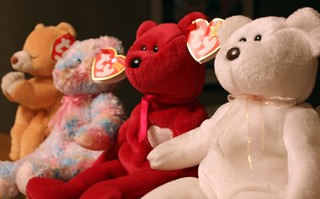 John Highfill, Founder, National Silver Dollar Roundtable, David Lisot, Interviewer, CoinTelevision.com.
John Highfill, Founder, National Silver Dollar Roundtable, David Lisot, Interviewer, CoinTelevision.com.
John Highfill is famous for dealing silver dollars and founding the National Silver Dollar Roundtable. He is an astute businessman who recognizes a business when he sees one. Hear the story of how he sold a billion dollars worth of Beanie Babies.
An excerpt of the video is available for viewing on the Coin Television YouTube Channel at:
https://youtu.be/8V6aefjgyEQ
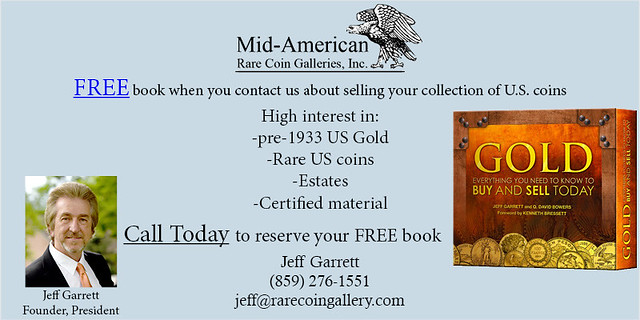
COINS IN LUCITE
Justin J. Perrault writes:
"I loved that old Esquire ad about a cigarette lighter with coins embedded in Lucite. Yes, I am sure it has really "held its value." Embedding things in Lucite seemed to be all the rage those days. I have a letter holder from the 1960's that has a general selection of period US coins embedded into it. A few months ago I also picked up a booklet from the 1960's that gave detailed instructions on how to create a decorative piece with anything embedded in Lucite, an interesting piece of ephemera for sure."
Bruce Perdue writes:
"I have two lighters with coins embedded in Lucite. One has a 1962 proof set embedded in the Lucite. The second one has random coins; a 1964 Quarter, 1964 nickel, and a 1953 dime. I also had a lighter similar to the one in the ad, however, it met an untimely end when it fell to the floor and shattered."
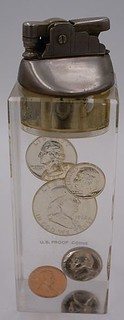
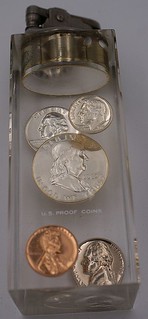
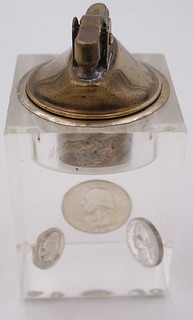
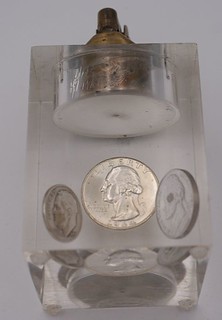
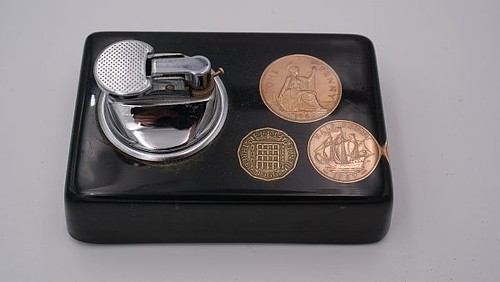
I grew up in a house with ashtrays in nearly every room, including the bathrooms. My own homes have never had ashtrays and our children would recognize neither ashtrays nor cigarette lighters. Interesting artifacts of a bygone era. Smoking hasn't disappeared of course, but these types of lighters have gone the way of the buggy whip and carpet beater. -Editor
Bruce adds:
"I have other Lucite items that might be of more interest to the E-Sylum audience. There are several that have no mate and several pairs. These are all hand made. A layer of acrylic is poured into what is usually a cardboard mold and the coins are placed by hand into the acrylic, a layer at a time. Each layer has to set partially before the next is placed.
None of these are proof sets. The single wedge-shaped bookend has 1973 uncirculated cents."
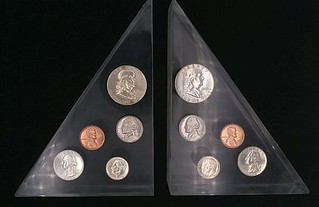
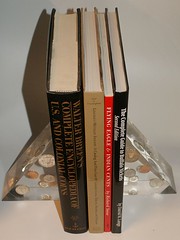
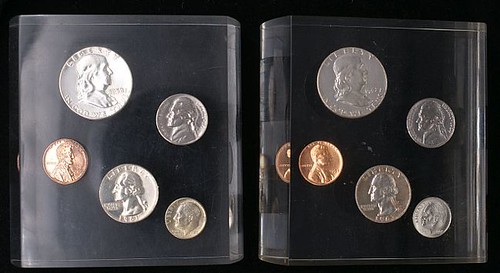
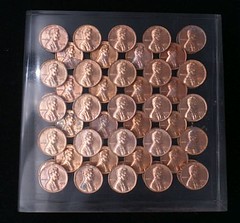
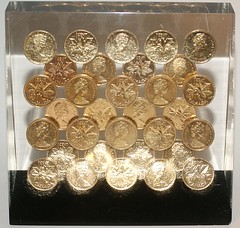
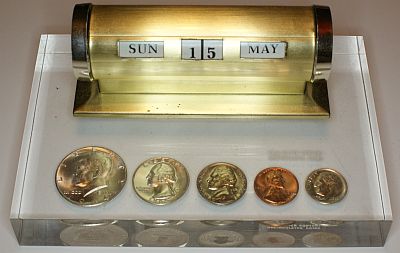
Cool stuff. Thanks! Here's something I keep on my desk and still use on occasion - my own Lucite letter opener with various coins embedded. -Editor


To read the earlier E-Sylum article, see:
NOTES FROM E-SYLUM READERS: NOVEMBER 22, 2020 : U.S. Proof Coin Paperweight-Lighter
(https://www.coinbooks.org/v23/esylum_v23n47a10.html)
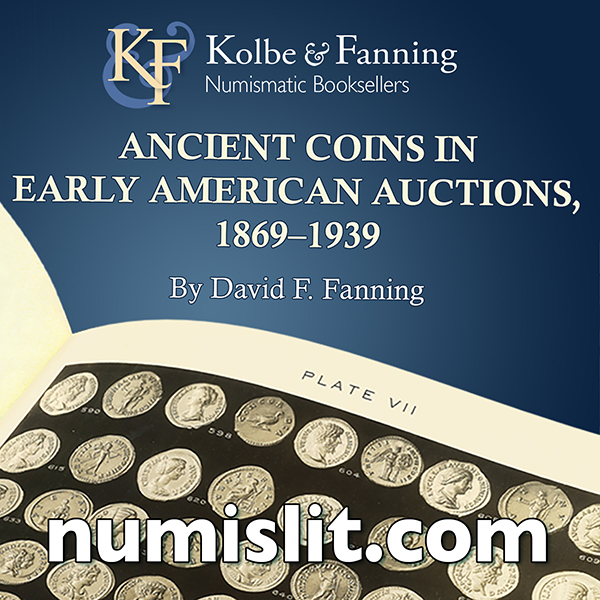
IMITATION GUINEAS AND HALF-GUINEAS
Author Martin Warburton submitted this note on the imitation guineas and half-guineas discussed earlier. Thank you! -Editor
Even More on the Good Old Days
Further to the last two weeks' pieces in The E-Sylum on tokens with the legend 'In Memory of the Good Old Days', Martin Purdy is absolutely correct in saying that these tokens were largely produced in the late Victorian era and the first decades of last century. They are commonly found in dealers' trays and on internet auction sites in base metal and, together with similar tokens, are known as imitation guineas or half-guineas.
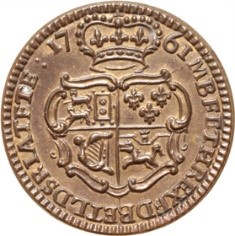 There are about 150 varieties of the 'In Memory' type. Earlier types of Queen Anne and George III,
resembling the regal guinea and half-guinea coinage in both design and legend, account for about
another 350 die varieties - 150 with the early ornate shield and 200 with the spade-shaped shield as
used on the later George III's guineas.
There are about 150 varieties of the 'In Memory' type. Earlier types of Queen Anne and George III,
resembling the regal guinea and half-guinea coinage in both design and legend, account for about
another 350 die varieties - 150 with the early ornate shield and 200 with the spade-shaped shield as
used on the later George III's guineas.
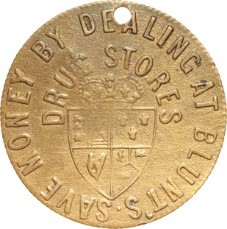 All the above types were probably produced as gaming counters. In addition, there are imitation
guineas used as advertising pieces. About 450 different varieties of these are known and usually
depict George III and/or a spade shaped shield, together with some reference to the maker of the token
or to the product, or establishment. being advertised.
All the above types were probably produced as gaming counters. In addition, there are imitation
guineas used as advertising pieces. About 450 different varieties of these are known and usually
depict George III and/or a spade shaped shield, together with some reference to the maker of the token
or to the product, or establishment. being advertised.
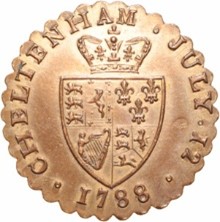 Finally, there are about 70 varieties of commemorative imitation guineas and half-guineas produced
mainly in conjunction with George III's visits to Cheltenham and Worcester, and also to celebrate his
recovery from bouts of ill-health. Most, but not all, of the commemorative varieties are listed in
Dalton & Hamer - a publication well-known to collectors of British 18th century tokens.
Finally, there are about 70 varieties of commemorative imitation guineas and half-guineas produced
mainly in conjunction with George III's visits to Cheltenham and Worcester, and also to celebrate his
recovery from bouts of ill-health. Most, but not all, of the commemorative varieties are listed in
Dalton & Hamer - a publication well-known to collectors of British 18th century tokens.
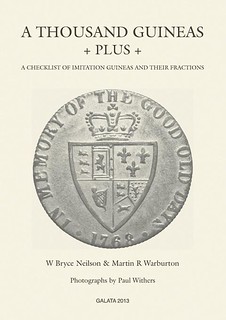 An illustrated checklist of all these types of imitation guineas and half-guineas was published in 2013
by Galata Print in the UK: - 'A Thousand Guineas Plus' by Bryce Neilson & Martin R Warburton.
An illustrated checklist of all these types of imitation guineas and half-guineas was published in 2013
by Galata Print in the UK: - 'A Thousand Guineas Plus' by Bryce Neilson & Martin R Warburton.
For more information, or to order, see:
A Thousand Guineas Plus. A Checklist of Imitation Guineas and their Fractions
(https://www.galata.co.uk/a-thousand-guineas-plus-a-checklist-of-imitation-guineas-and-their-fractions)
To read the earlier E-Sylum articles, see:
More on The Good Old Days
(https://www.coinbooks.org/v23/esylum_v23n47a10.html)
NOTES FROM E-SYLUM READERS: NOVEMBER 15, 2020 : The Good Old Days
(https://www.coinbooks.org/v23/esylum_v23n46a12.html)
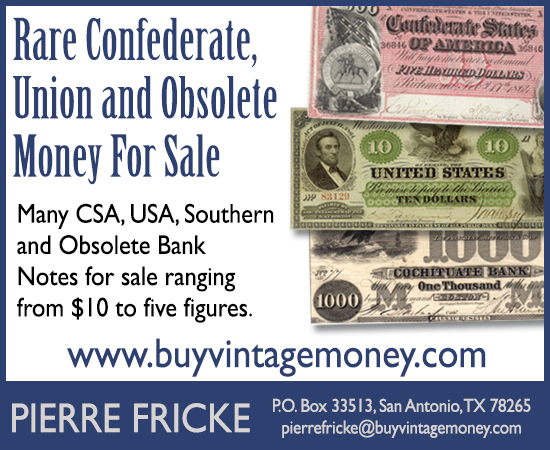
NOTES FROM E-SYLUM READERS: NOVEMBER 29, 2020
Reader Thoughts on First Coins of the Americas
Robert Hoge,
Curator Emeritus, American Numismatic Society writes:
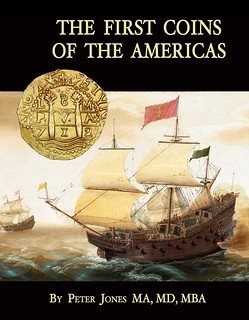 "I was very pleased to see the new book The First Coins of the Americas, by Dr. Peter Jones, referenced in the latest E-Sylum. This is a wonderful work. If there had been such a book available many years ago, I think I might have dedicated myself to studying and working on collecting these kinds of issues instead of having become very much of a generalist. Although I have indeed often focused from time to time on these series, over the years, there was much material and information in it that was of interest, and essentially new to me!
"I was very pleased to see the new book The First Coins of the Americas, by Dr. Peter Jones, referenced in the latest E-Sylum. This is a wonderful work. If there had been such a book available many years ago, I think I might have dedicated myself to studying and working on collecting these kinds of issues instead of having become very much of a generalist. Although I have indeed often focused from time to time on these series, over the years, there was much material and information in it that was of interest, and essentially new to me!
"I highly recommend this volume!"
Thanks. Book reviews, however long or short, are always appreciated. If you pick up a new volume over the holidays, drop us a line and let our readers know what you think. -Editor
To read the earlier E-Sylum article, see:
NEW BOOK: THE FIRST COINS OF THE AMERICAS
(https://www.coinbooks.org/v23/esylum_v23n47a04.html)
Numismatic Cats
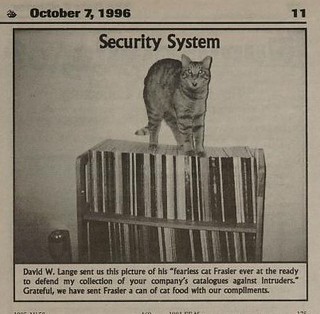 George Kolbe writes:
George Kolbe writes:
"As noted by Dave Lange, our feline friends do seem to have an affinity for numismatic catalogues. Several Kolbe sales in the 1990s featured selections from the library of NBS co-founder Jack Collins. In one of them, Jack's special hardbound edition of Lester Merkin's iconic 1964 Louis Helfenstein auction sale catalogue was featured. Minor discoloration on the cover was noted. Left unsaid was the origin of the stain: Jack's intrepid cat had employed the volume to mark its territory."
Ken Lowe was a cat lover as well. Perhaps some Money Tree lots suffered the same fate. -Editor
To read the earlier E-Sylum article, see:
MORE ON BOWERS & MERENA'S THE COIN COLLECTOR
(https://www.coinbooks.org/v23/esylum_v23n47a06.html)
More on Numismatics and U.S. Customs
Alan V. Weinberg writes:
"Concerning John Nebel's 2016 experience with Customs putting a lengthy, documents-required hold on his three Ancient Greek coins, this is still going on today.
"On Sept 23, 2020 at 2:30 AM California time, I successfully phone bid on a rare silver United States US Mint medal being offered in a well-known Great Britain antique house auction. I paid several hundred dollars for an Express FedEx shipment of the medal after Express FedExing a cashiers check to the auction house.
"Homeland Security / Customs held it for a month in Memphis, requiring my signing online documents on what it was and even then held it until I made several insistent phone calls to a Missouri-based FedEx customs specialist who interceded on my behalf. I finally received it only because of my and her efforts.
"What the acquisition of an old US Mint Civil War medal being returned to the US from overseas has to do with Homeland Security I don't know.
"It was an 1864 silver General Benj. Butler silver Colored Troops medal with original ribbon and silver clasp in original case with a handwritten Butler note addressing his part in having the medal designed, struck and awarded. The movie Glory with Denzel Washington and Matthew Broderick highlights the medal's historical background."
Thanks. Here's an example of the medal we discussed in 2017. Well worth the trouble to acquire! -Editor
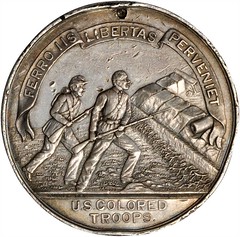
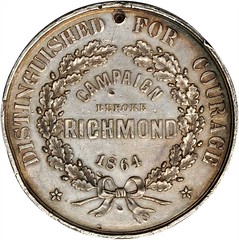
To read earlier E-Sylum articles, see:
BLACK HISTORY IN NUMISMATICS
(https://www.coinbooks.org/v20/esylum_v20n07a13.html)
POLITICS OF ANCIENT NUMISMATICS
(https://www.coinbooks.org/v23/esylum_v23n47a20.html)
More on The Cohen Mint
Stephen Olson of Kalamazoo, Michigan had written earlier to ask for information about The Cohen Mint. E-Sylum readers are rarely stumped, but no one has come up with anything yet. Here's a little more background from Stephen. -Editor
He writes:
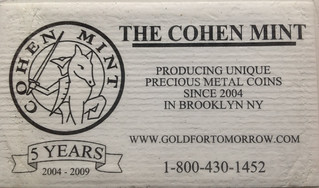 "I see that the mysterious Eilan Cohen and his mint in Brooklyn, are exactly that, mysterious! I have enclosed photos of the few items that I've purchased earlier this year that are products of the Cohen Mint. Even his LOGO is shrouded in mystery! It appears to be a Paul Revere type of soldier, mounted on a horse. In the case of his Rhodium tokens, he uses an American Eagle motif on the reverse. On his 1g gold tokens from 2004, the reverse is the NYC skyline with the Twin Towers centrally located. His 1/4g Rhodium tokens are very small, with "1/4g" engraved on the reverse.
"I see that the mysterious Eilan Cohen and his mint in Brooklyn, are exactly that, mysterious! I have enclosed photos of the few items that I've purchased earlier this year that are products of the Cohen Mint. Even his LOGO is shrouded in mystery! It appears to be a Paul Revere type of soldier, mounted on a horse. In the case of his Rhodium tokens, he uses an American Eagle motif on the reverse. On his 1g gold tokens from 2004, the reverse is the NYC skyline with the Twin Towers centrally located. His 1/4g Rhodium tokens are very small, with "1/4g" engraved on the reverse.
"Fascinating man, who dedicated his life to minting a metal, so much more valuable than gold, but so hard & brittle, that it was never before "mintable." Interesting that when he finally discovered a process for minting it in 2009, he died shortly thereafter! The Cohen Mint was only in existence from 2004-2009, so I believe that any of his Rhodium tokens are well worth checking out, as their rarity, both in terms of the metallic value, but also scarcity of the tokens themselves, make them a very sound investment for any collector. All too often opportunity passes before it's realized in hindsight.
"Thank you for keeping it out there for all who are interested & hopefully someone can add anything to my scant knowledge & hopefully, the mystery of Mr. Cohen & his mint can be made a little less mysterious!"
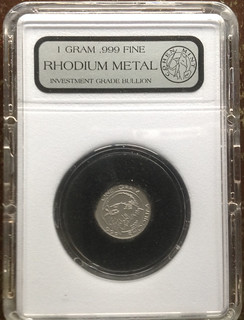
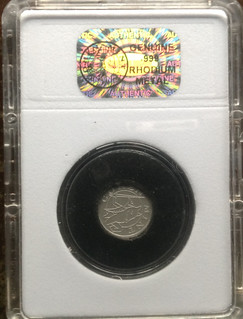
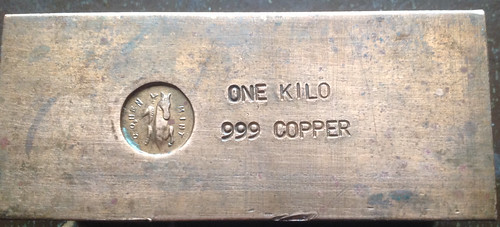
Do these images help spur any recollections? Any additional information on Cohen and his mint would be appreciated. Thanks.
FWIW, the new Newman Portal web search tool located some discussions on the CoinTalk, Coin People and PCGS forums in the 2009-2010 timeframe. -Editor
To read the earlier E-Sylum articles, see:
NOTES FROM E-SYLUM READERS: OCTOBER 25, 2020 : Query: The Cohen Mint
(https://www.coinbooks.org/v23/esylum_v23n43a12.html)
NEWMAN PORTAL WEB SEARCH
(https://www.coinbooks.org/v23/esylum_v23n46a08.html)
On Medals of Honor
Jim Downey writes:
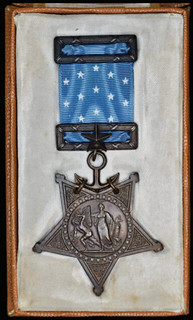 "Regarding Howard Daniel's mention of the auction for a US Navy Medal of Honor, the Medal of Honor is legal to possess in the United States but it is illegal to buy, sell, manufacture, import or export. The unfortunate result of the misguided US law is that foreigners are free to trade in them but US residents may not. The prohibition includes the medal, ribbon or rosette.
"Regarding Howard Daniel's mention of the auction for a US Navy Medal of Honor, the Medal of Honor is legal to possess in the United States but it is illegal to buy, sell, manufacture, import or export. The unfortunate result of the misguided US law is that foreigners are free to trade in them but US residents may not. The prohibition includes the medal, ribbon or rosette.
"All Medals of Honor are issued named. This one was unnamed indicating it was probably a display copy."
Thanks. -Editor
To read the earlier E-Sylum article, see:
U.S. NAVAL MEDAL OF HONOR AUCTIONED
(https://www.coinbooks.org/v23/esylum_v23n47a26.html)
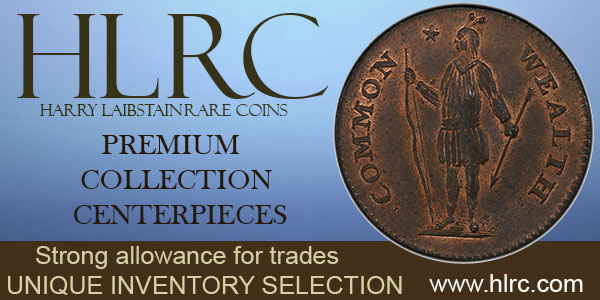
NGC PHOTO PROOF HISTORY
Dave Lange writes:
"Jeff Garrett's article about the transition to digital photography in numismatics overlooked an important milestone. NGC was likely the first company to employ this technology when it launched Photo Proof late in 1994. The official announcement was published in Coin World and Numismatic News on the covers of their first issues dated 1995.
"I'm intimately familiar with this development, as I was hired by NGC the year before specifically to write the text for Photo Proof. Even today it remains a small part of my overall workload, though at that time it was anticipated I'd be occupied with this one service all day, every day. Indeed, the first couple years were extremely busy ones, both in terms of writing and in the promotional efforts. At the 1995 FUN Show and that same year's ANA Convention in Anaheim I actually manned a separate Photo Proof booth, and the "proof" of this is attached.
"These days nearly everyone can perform their own digital photography with varying degrees of prowess, so the demand for Photo Proof has diminished. Still, NGC has expanded its line of photographic services to fill other needs of dealers and collectors, and the quality of these images is superb. Over the past quarter century NGC has produced many thousands of Photo Proofs, but how many still exist is unknown---yet another collectible to seek."
Dave provided these images. Thanks! -Editor
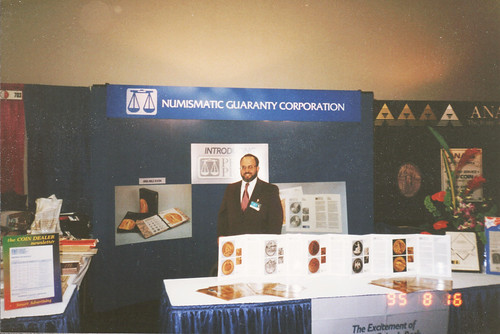
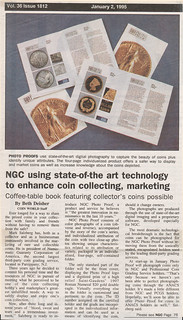
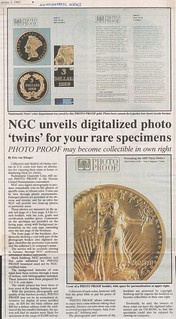
Coin World and Numismatic News coverage
To read the earlier E-Sylum article, see:
DIGITAL PHOTOGRAPHY: A NUMISMATIC GAME-CHANGER
(https://www.coinbooks.org/v23/esylum_v23n47a11.html)
THE BOOK BAZARRE
COLLECTING WHITMAN BOOKSHELF ALBUMS
Dave Lange recently published Coin Collecting Albums, A Complete History & Catalog: Volume Three, Whitman Publishing Company Folders and Albums 1940-1978. In an email to his mailing list this week, he provided a section inadvertently left out of the book. With permission, we're republishing it here. Thanks. -Editor
Dave writes:
"A sharp-eyed reader of my new book inquired why there was no section titled "Collecting Bookshelf Albums," as there are equivalent sections on each of the other Whitman products. The simple answer is that it was written and somehow lost during the layout process. I failed to notice this omission, a great embarrassment to me.
"It is attached herein, along with a photo of the author's own collection of these albums."
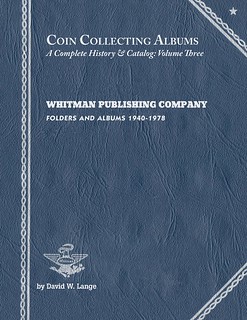 Produced from 1961 through 1978, the Bookshelf is the most commonly seen obsolete coin album, slightly
edging out those from the Library of Coins, which lasted only until 1971. From the very beginning Whitman's line of
titles was extensive. All series of non-gold, USA coins had their own albums for issues dated roughly 1837 and later,
the sole exception being Liberty Seated Dollars. For earlier coin series only Half Cents, Large Cents and Bust Half
Dollars were provided their own albums. The more inclusive Library of Coins line did offer the missing Whitman
titles, and they thus retain fairly high resale values more than 50 years after they were printed. Conversely, most
Bookshelf albums are reasonably priced in the aftermarket.
Produced from 1961 through 1978, the Bookshelf is the most commonly seen obsolete coin album, slightly
edging out those from the Library of Coins, which lasted only until 1971. From the very beginning Whitman's line of
titles was extensive. All series of non-gold, USA coins had their own albums for issues dated roughly 1837 and later,
the sole exception being Liberty Seated Dollars. For earlier coin series only Half Cents, Large Cents and Bust Half
Dollars were provided their own albums. The more inclusive Library of Coins line did offer the missing Whitman
titles, and they thus retain fairly high resale values more than 50 years after they were printed. Conversely, most
Bookshelf albums are reasonably priced in the aftermarket.
Whitman Bookshelf albums are case bound, as with a hardcover book, and this ultimately contributed to the line's undoing years later. With frequent use the covers of Bookshelf albums can separate from their stubs, as they are attached solely by heavy staples that are covered by the pastedown paper. If one attempts to make the albums lie flat, the pastedown can tear away from the staples, and many used Bookshelf albums are found in this state. Another condition issue is that the gold printing of the front cover and spine tends to wear off of Bookshelf albums from the First Edition. Early in the Second Edition, Whitman adopted metallic gold printing that was brighter from the outset and far more durable. This serendipitous development lasted only 1972-74, and for the final few years of production the cover text reverted to its former matte finish, probably for cost reasons.
There are many rarely seen albums in the Bookshelf line, but that does not necessarily translate to high values. The secondary market for these albums as a whole is not strong, despite their very attractive design and color scheme. When they are sought, it is for use in storing coins and not as collectibles in their own right. Actually, there are a number of individual varieties within particular titles that are quite rare, but the collecting of these albums to such a degree is perhaps an affliction suffered by the author alone.
The real market in Whitman Bookshelf albums is a practical one, limited mostly to persons who recall them from the 1960s-70s and wish to continue their collections utilizing these familiar products. The author, too, employs Whitman Bookshelf albums for all of his circulated coin series to great satisfaction. He also finds that certain titles are always worth purchasing for resale whenever found in nice condition, and these include all those for Liberty Seated coins. Another good seller is the Bookshelf album for Large Cents, though experience has demonstrated that its opening are sometime a big snug for early date cents.
The only titles that consistently realize high prices in the secondary market are those for which other albums are lacking today. The most highly sought ones are the type set albums for Mexico, Panama and The Philippines. These are legitimately rare and in constant demand. Still desirable but less costly are the several albums for Canada, Great Britain and Australia. The Canadian Large Cents album and the Newfoundland type set album in particular are fairly scarce and can bring good money. Of the British albums, the most valuable on the secondary market are those for Queen Victoria's farthings, halfpennies and pennies by date, mint and variety, 1860-1901.
The various albums for tokens and medals are all very scarce, as are some of the custom printings for Presidential Art Medals, Inc. The latter are found either with or without the medals, and those featuring medals often are lacking some of later entries in their respective series. Over a period of years many subscribers to these medals lost interest and dropped out of the pursuit. The three albums for the Presidential Series, the first one launched, are the easiest to find. The later Statehood Series is noticeably scarcer in both the medals and the albums, particularly Volume 2. The Declaration Signers Series medals were of limited interest from the outset, and both the medals and the albums are rare. Volume III of that series is perhaps the rarest of all Bookshelf albums, and it is the only entry in all three series to bring a strong price in auction sales.
Another very rare Bookshelf album is the custom printing for Franklin Mint. This album holds the first series of dollar tokens coined for Nevada gaming casinos after the disappearance of silver dollars in 1964. The two varieties listed in the First Edition catalog are quite are with or without the medals, yet empty examples do not bring very high prices. As of this writing there is little collector interest in the albums themselves. Also of limited interest and modest aftermarket value are the two albums for Israeli coins custom printed for R. P. Nielsen.
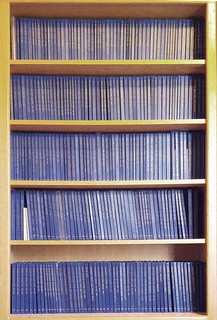 A complete set of Whitman's Bookshelf albums is quite beautiful in one's bookcase, as the publisher intended,
but the number of persons attempting to assemble all the various titles will likely remain limited. Publication of this
book may attract new collectors and higher prices in the long term.
A complete set of Whitman's Bookshelf albums is quite beautiful in one's bookcase, as the publisher intended,
but the number of persons attempting to assemble all the various titles will likely remain limited. Publication of this
book may attract new collectors and higher prices in the long term.
If you own a copy of the book, contact Dave at DavidWLange@outlook.com and he'll send you a .pdf file you can print and insert into your copy. -Editor
For more information, or to order Dave's book, see:
https://www.coincollectingboards.com/
To read the earlier E-Sylum article, see:
NEW BOOK: COIN COLLECTING ALBUMS, VOLUME THREE
(https://www.coinbooks.org/v23/esylum_v23n25a03.html)

VOCABULARY TERM: OBSESSIVE DATE
Dick Johnson submitted this entry from his Encyclopedia of Coin and Medal Terminology. Thanks. -Editor
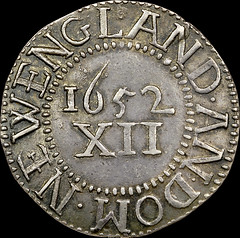 Obsessive Date.
Retaining a previous year's date on coins struck into the following year or years. The word obsessive, meaning the continuation of some design element, perhaps after it is necessary; this is equal to the British term immobilized (as retaining monarch's portrait after his death, say). Obsessive dating occurred in American Colonial coinage with the Massachusetts silver coins, which bore the date 1652, continued to be struck for thirty years thereafter. In Great Britain, the 1925 gold sovereign was struck by the Royal Mint from 1926 to 1949 as another example. The Maria Theresa Thaler, struck well into the 21st century, has borne the 1780 date for over 200 years.
Obsessive Date.
Retaining a previous year's date on coins struck into the following year or years. The word obsessive, meaning the continuation of some design element, perhaps after it is necessary; this is equal to the British term immobilized (as retaining monarch's portrait after his death, say). Obsessive dating occurred in American Colonial coinage with the Massachusetts silver coins, which bore the date 1652, continued to be struck for thirty years thereafter. In Great Britain, the 1925 gold sovereign was struck by the Royal Mint from 1926 to 1949 as another example. The Maria Theresa Thaler, struck well into the 21st century, has borne the 1780 date for over 200 years.
I added the image. That's not a term I'd heard before. I know the concept, but didn't realize there was a word for it. Thanks, Dick. -Editor
Looking for the meaning of a numismatic word, or the description of a term? Try the Newman Numismatic Portal's Numismatic Dictionary at: https://nnp.wustl.edu/library/dictionary
Or if you would like a printed copy of the complete Encyclopedia, it is available. There are 1,854 terms, on 678 pages, in The Encyclopedia of Coin and Medal Technology. Even running two a week would require more than 19 years to publish them all. If you would like an advance draft of this vital reference work it may be obtained from the author for your check of $50 sent postpaid. Dick Johnson, 139 Thompson Drive, Torrington, CT 06790.
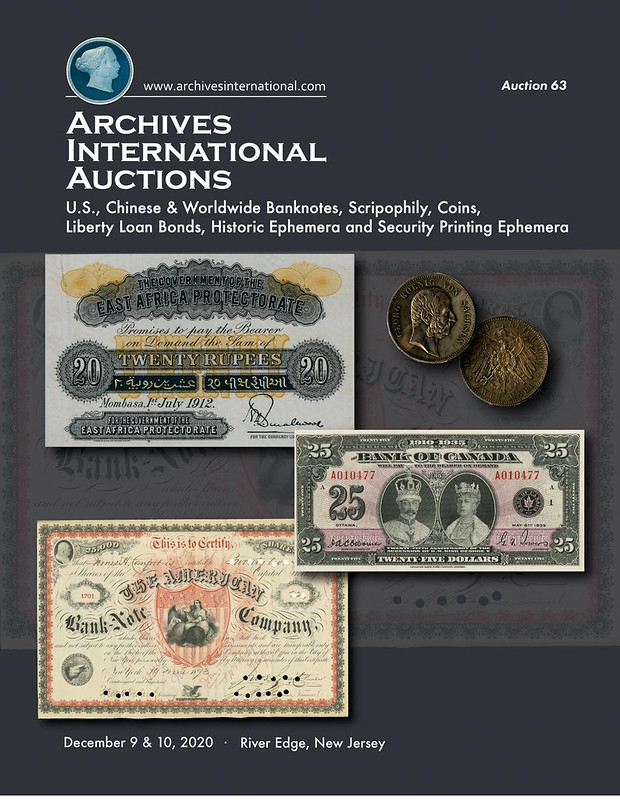
FRANK DEWETTE ANDREWS (1847-1937)
John Lupia submitted the following information from the online draft of his book of numismatic biographies for this week's installment of his series. Thanks! As always, this is an excerpt with the full article and bibliography available online. This week's subject is collector and author Frank D. Andrews. I added an image and link to Andrews' classic 1881 work. -Editor
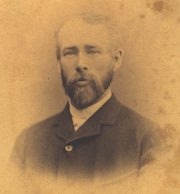 Andrews, Frank DeWette (1847-1937), was born on August 1, 1847 in Southington, Hartford County, Connecticut, the son of Bennet Josiah Andrews (1806-1860) and Lavinia Frost (1817-1899).
Andrews, Frank DeWette (1847-1937), was born on August 1, 1847 in Southington, Hartford County, Connecticut, the son of Bennet Josiah Andrews (1806-1860) and Lavinia Frost (1817-1899).
He was a descendant of John Andrews an original proprietor of Farmington in 1640. As a young boy Andrews developed what would grow into a life-long avid interest in geology, genealogy, numismatics, philatelics, antiquarian history and Indian relics.
According to the 1870 U. S. Census the family owned and worked a prosperous estate farm and Andrews personal estate was valued at $4,000. While farming in Southington, Andrews married Kittie Gallup (1842-1880) on December 16, 1868. In 1869 he and his family moved to South 7th Street, in what was then called Landis Township, Cumberland County, New Jersey.
His wife having died sometime prior to June 1880, led him to occupy his mind by writing his book, A Description of 268 Varieties of United States Cents, 1816-1857 in the Collection of Frank D. Andrews (1881). He tells us about this in his own words :
"I will say here, that, for the want of something to closely occupy and engage the mind, I attempted the work upon the United States cents 1816-57 . . . There is nothing . . . to enable one to endure sorrow as constant occupation, which shall keep the mind from dwelling upon its loss."
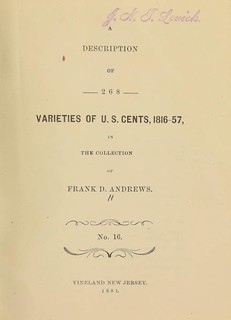 Andrews self-published the book in only forty copies. He explains this in his author's preface in the fifty-four page pamphlet :
Andrews self-published the book in only forty copies. He explains this in his author's preface in the fifty-four page pamphlet :
Believing this pamphlet to be of value for reference to others as well as myself, I have issued a small edition, forty copies, part of which I intend distributing among my coin collecting friends, for the remainder, should anyone desire a copy, the price will be twenty-five cents each. FDA February 10, 1881."
The scarcity of copies drove up the price of this fifty-four page pamphlet and by 1884 we find a record that it realized a price of $4.00 at public auction.
His numismatic interests also led him to become a corresponding member of the ANS since June 12, 1883. During this time he lived with his twice-widowed mother Lavinia A. Norton and his elder widowed sister Emma Belinda Gridley at his home in Vineland, New Jersey.
It was at his home in Vineland that Andrews found himself publishing a revised edition of his original 1881 pamphlet on United States cents. Andrews' second book on Large Cents, An Arrangement of United States Copper Cents 1816-1857, for the Assistance of Collectors (Vineland, N. J., 1883), printed in forty-two pages is given its first public notice in March 1883.
An Arrangement of United States Copper Cents 1816-1857, for the Assistance of Collectors, by Frank D. Andrews, Vineland, N.J. The work, a 42 page pamphlet, published by Mr. Andrews at 50 cts. Per copy, describes the minute variations in dies of over 400 copper cents, beginning with 1816, and continuing until the end of the coinage, in 1857. Each date, obverse and reverse, is under a separate heading, with a numerical arrangement for the obverses and an alphabetical one for the reverses, also a short, concise, and easily understood system of definitions, occupying not over one line for each variation, tabulated, and referring to the position of curl to date, of star to coronet, points of leaves to legend, etc. Striking peculiarities in date, cracked dies, etc., are also enumerated, and in its present shape the work of Mr. Andrews will prove of positive interest and usefulness to collectors of the cents issued from 1816 to 1857, decidedly superior in every particular to his former work on the subject. Twenty-five copies are printed on thick paper, with blank leaves inserted.
Several years later, he became a Trustee of the Vineland Historical and Antiquarian Society in 1888. Two years later, he married Rebecca "Bessie" Graham Ayars (1849-1921) on April 10, 1890 at Greenwich, New Jersey. About this time he began to assist in land acquisition for the Library building of the Vineland Historical and Antiquarian Society, which he endowed. By July 1894 the small building housed a collection of curiosities and relics as well as books and documents.
In 1931 an addition was built onto the Vineland Historical Society Library containing "Andrews Room". In 1932 a stately portrait of Andrews was painted by August Franceschi. He continued as Editor-in-Chief of the Vineland Historical Magazine up until his death at Philadelphia on January 28, 1937.
To read the 1881 Andrews work on the Newman Numismatic Portal, see:
A description of 268 varieties of U.S. cents, 1816-57, in the collection of Frank D. Andrews, 1881.
(https://nnp.wustl.edu/library/book/562598)
To read the complete article, see:
ANDREWS, FRANK DEWETTE
(http://www.numismaticmall.com/numismaticmall-com/andrews-frank-dewette)

JEFF BURKE'S NEW 1880-S MORGAN DOLLAR
Jeff Burke submitted this report on researching his latest U.S. type coin acquisition. Thanks. Thanks also to Julian Leidman of Bonanza Coins for use of the photos. -Editor
"Morgan Dollar Bibliography Note"
Jeff Burke
Since I wrote about my Lincoln Cent hunt in the July 19, 2020 issue of The E-Sylum, I have continued my search of high-grade, well-struck and inexpensive type coins by seeking to add a mint state Morgan dollar to my collection. Before launching my Morgan dollar treasure hunt, I watched an ANA recorded webinar – "Collecting and Investing in Morgan Dollars: A Comprehensive Approach," taught by John Baumgart and Dr. Michael S. Fey earlier this year. I also reread sections of Girl on a Silver Dollar, Roger W. Burdette, 2019; The Private Sketchbook of George T. Morgan, Karen M. Lee, 2013; The Complete Virtual Guide to Pricing Your Morgan Silver Dollars (1878-1921), Dr. Michael Fey, 2019; Numismatic Photography, Mark Goodman, 2008; A Guide Book of Morgan Silver Dollars, Q. David Bowers, 2006; and Pleasure & Profit: 100 Lessons for Building and Selling a Collection of Rare Coins, Robert W. Shippee, 2014.
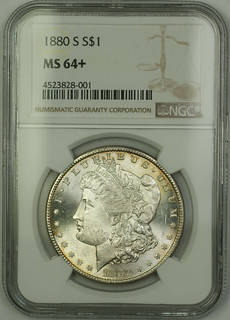
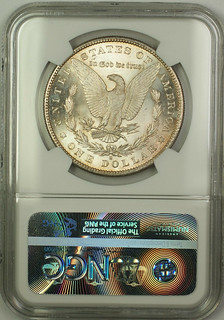
I narrowed down my target coin to an 1880-S or 1881-S Morgan dollar. According to David Bowers, these particular pieces are among the most well-struck, plentiful, and beautiful coins in the series (see Bowers, Guide Book, pp. 135, 141).
I prefer Morgan dollars in mint state with frosty snow white surfaces. Recently, I have come to appreciate naturally toned Morgan dollars in beautiful colors as well as prooflike specimens. I studied numerous coins online before making my selection. I finally decided to purchase an 1880-S NGC MS64+ from Bonanza Coins that I spotted on Collectors Corner.
This wonderous coin arrived in the mail today. I love the golden toning around the periphery of both sides! It is an unusual piece that lacks the excessive bag marks of so many cartwheels.
Nice coin! -Editor
To read the earlier E-Sylum article, see:
JEFF BURKE'S NEW 1909 V.D.B. LINCOLN CENT
(https://www.coinbooks.org/v23/esylum_v23n29a23.html)
2020 ANA RACHEL CARSON CONVENTION MEDAL
The Pennsylvania Association of Numismatists was a local sponsor for the cancelled Pittsburgh 2020 ANA World's Fair of Money Convention. PAN Chairman of the Board Don Carlucci penned a nice article for their journal The Clarion about the medal's conception and design. With permission we're publishing an excerpt here. Thanks to Clarion editor Rich Jewell for providing the text and images. -Editor
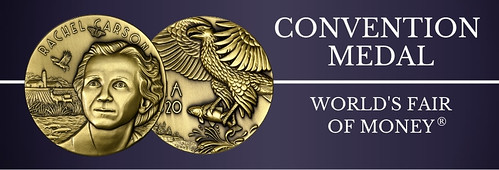
Miss Carson's last and most famous volume, of course, was "Silent Spring." Published in 1962, it was the result of more than four years of investigation, research, and writing. Its publication resulted in an instant storm of protest and controversy. At issue was the widespread and growing use of pesticides, insecticides, DDT and other harmful chemicals.
Carson's assault on pesticides and herbicides shocked 1962 Americans, who generally viewed these chemicals as the latest marvel from the awesome scientists whose previous inventions and discoveries had won World War II.
Aquatic life was being impacted. Fish and crayfish were dying and frogs, tadpoles, and other forms of amphibious life were disappearing. And at the higher level of nature's food chain, our national symbol, the bald eagle, was starting to diminish in numbers when they consumed the lower levels of wildlife that were first contaminated by these pesticides.
While the down-hill plight of the American eagle was occurring, Rachel Carson's book "Silent Spring" jumped to the top of the New York Times best-seller list, and staying there for more than six months, selling more than 600,000 copies. At this point, a major war was declared by the chemical companies and their supporters against Rachel Carson and her writings.
The National Agricultural Chemical Association launched an anti "Silent Spring" public relations blitz that depicted her as a Luddite whose ideas, if followed, would cause the world to starve.
All of these attacks from both industry and government failed. Carson remained appealing, slight in stature, soft-spoken, modest, but forever confident. Her three previous books, all best-selling poetic guides to the seas and its creatures – had earned her a reserve of credibility.
Rachel Carson only lived about eighteen months after the publication of her most important book, "Silent Spring." On April 14, 1964, a month before her 57th birthday, she died in a hospital in the Maryland suburb of Silver Spring from complications of metastasizing breast cancer.
Rachel Carson did not live to see the positive impact of her message, including prohibition of the agrichemicals aldrin, dieldrin, and heptachlor; passage of the National Environmental Policy Act; establishment of the United States Environmental Protection Agency; and the environmental protection agencies established in each state, comparable to the State of Pennsylvania Department of Environmental Protection. Finally, because of her writings and reports, DDT was banned in the United States in 1972 and the end of its use by much of the world's farming industry within the next fifty years.
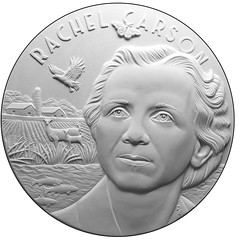
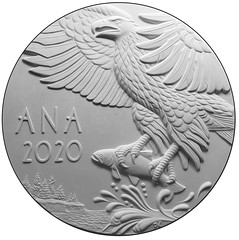
To design a medal that would best depict Rachel Carson and all that she stood for, and all that she represented, we need a first-class sculpture engraver. With the assistance of another numismatic friend, Thomas Uram, the current president of the Pennsylvania Association of Numismatists, the name Donald Everhart was offered and accepted. Don has created over one thousand coin and medal designs. He was retired as the master engraver of the United States Mint in Philadelphia and was now accepting private commissions.
Don was the right candidate for this commission. If you should study the obverse of his medal you see Rachel surrounded by the nature that she was able to restore and preserve. The furrows in the farmer's stream runs rain runoff waters toward the body of water no longer conveying the DDT's or pesticides from a bygone era. The fish are alive in the stream with the deer standing resolutely on shore. A majestic eagle is in flight surveying everything that is now right with nature. And finally, the monarch butterfly, that Rachel famously proclaimed "always returns" is top centered on the medal as Rachel would have wanted.
On the reverse, our national symbol, the American bald eagle is holding a trout in its mighty talons, plucked from a non-contaminated stream, in flight, heading for the healthy young eaglets in its nest.
Only three ANA Conventions in history have been cancelled: 1918 (Spanish Flu), 1945 (WWII), and now 2020 (Covid-19). But the 2020 convention medal is nevertheless available to collectors, and it's a nice one. PAN and Don Everhart have done a great job. -Editor
To read the complete article, see:
2020 ANA World's Fair of Money Convention Medal
(https://www.money.org/wfm/convention-medal)
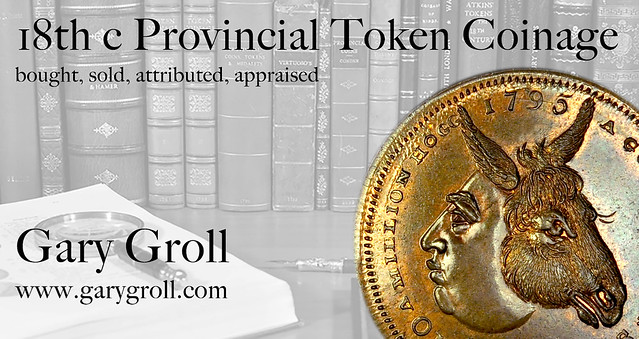
ONLINE LECTURE: BANK NOTES AND SHINPLASTERS
Robert Hoge passed along this announcement of a free online Massachusetts Historical Society program with Joshua R. Greenberg, author of Bank Notes and Shinplasters. Thanks. -Editor
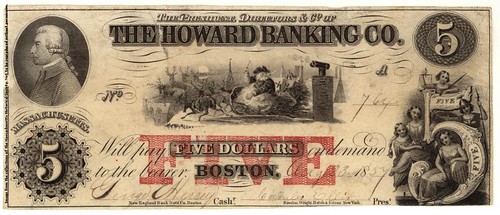
Bank Notes and Shinplasters: The Rage for Paper Money in the Early Republic
Registration required at no cost
7 December 2020.
Monday, 5:30PM - 6:30PM
Before Civil War greenbacks and a national bank network established a uniform federal currency in the United States, loosely regulated banks saturated the early American republic with upwards of 10,000 unique and legal bank notes. Joshua R. Greenberg shows how ordinary Americans accumulated and wielded the financial knowledge required to navigate interpersonal bank note transactions and argues that the shift from state-regulated banks and private shinplaster producers to federally authorized paper money in the Civil War era led to the erasure of the skill, knowledge, and lived experience with banking that informed debates over economic policy.
Please note, this is an online event held on the video conference platform, Zoom. Registrants will receive an email with links to join the program.
To register, see:
Bank Notes and Shinplasters: The Rage for Paper Money in the Early Republic
(https://www.masshist.org/calendar/event?event=3365)
To read the earlier E-Sylum article, see:
NEW BOOK: BANK NOTES AND SHINPLASTERS
(https://www.coinbooks.org/v23/esylum_v23n07a05.html)

LYN KNIGHT DECEMBER 2020 AUCTION SELECTIONS
The Lyn Knight November/December 2020 sale closes December 1, 2020. That's just days away, so be sure to get your bids in. Here are some selected lots. -Editor
Lot 80939: Argentina Banco Provincial de Cordoba 10 Pesos
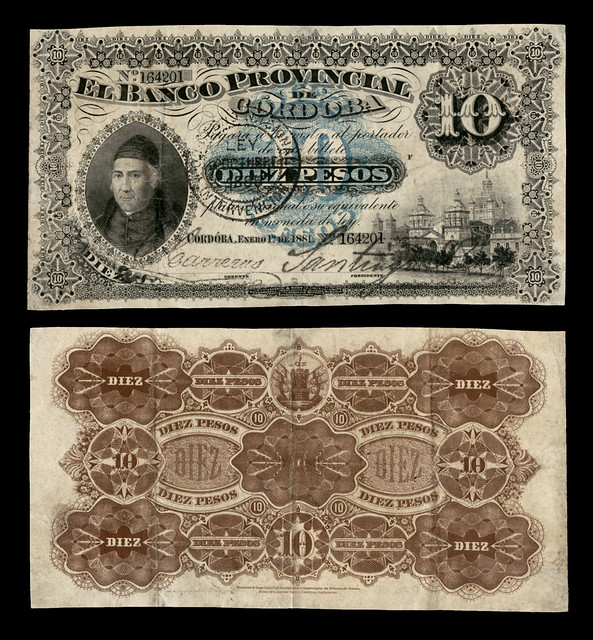
Argentina
Banco Provincial de Cordoba
S738b 10 Pesos 1.1.1881
Dean Funes and provincial cathedral/arms. PMG terms this "VF 30 minor restoration"; by itself, far better than the only other two examples on the population report.
A complex design - unusual, but still pleasant. -Editor
To read the complete lot description, see:
Argentina Banco Provincial de Cordoba 10 Pesos
(http://www.lynknight.com/items/1158768)
Lot 80964: Austria War Loan Replacement Corps
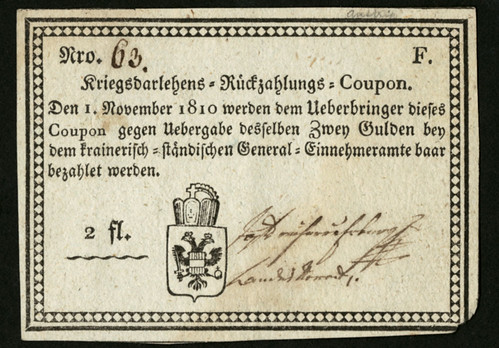
Austria
War Loan Replacement Corps
NL 2 Gulden/Florin 1.11.1810
Arms; uniface. Hand signed. Bottom right corner missing. The first I have seen. Sold as is; no returns.
I'd never seen one of these either. -Editor
To read the complete lot description, see:
Austria War Loan Replacement Corps
(http://www.lynknight.com/items/1158924)
Lot 80985: Banque du Congo Belge 1 Franc
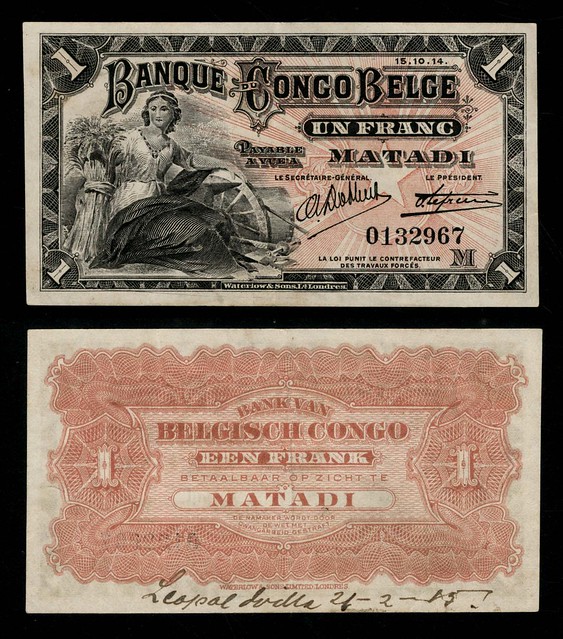
Belgian Congo
Banque du Congo Belge
3B 1 Franc 15.10.1914
Matadi. Woman seated with sheaf of grain and wheel. Writing on back for this original.
Bold front design - great color. -Editor
To read the complete lot description, see:
Belgian Congo
(http://www.lynknight.com/items/1156974)
Lot 81010: Banco Nacional de Bolivia 1 Boliviano
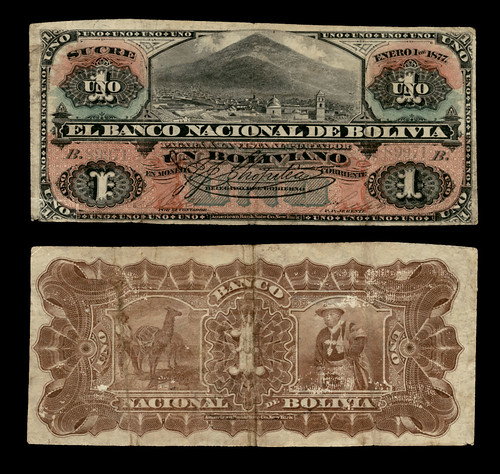
Bolivia
Banco Nacional de Bolivia
S199a 1 Boliviano 1.1.1877
Mountain and city of Potosi/Indian with llamas and Indian. PMG terms this "VF 25 previously mounted"; the better of only two examples on the population report.
An interesting compartmented design. -Editor
To read the complete lot description, see:
Banco Nacional de Bolivia 1 Boliviano
(http://www.lynknight.com/items/1158765)
Lot 81157: Chartered Bank of India, Australia & China 5 Mexican Dollars
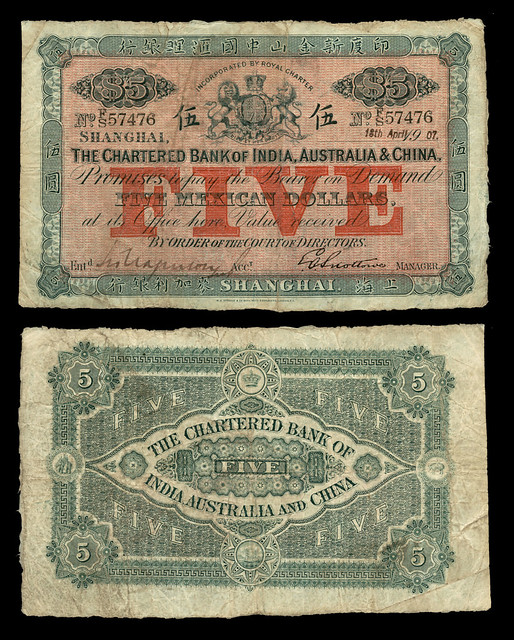
China
Chartered Bank of India, Australia & China
S192 5 Mexican Dollars 18.4.1907
As a stable currency for hundreds of years, the Mexican dollar was used for many decades in China and other parts of Asia. All Mexican dollar types in any collectible condition are inherently titillating and very difficult to come by. This example is particularly captivating. Strong original color, particular with the underprint. Supported royal arms at center. PMG terms this "VF 20" (and again the color gives an even better impression); only one better, at VF 25, of a mere five on the population report. A wonderful treasure for any collection.
An important and seldom-seen rarity. -Editor
To read the complete lot description, see:
Chartered Bank of India, Australia & China 5 Mexican Dollars
(http://www.lynknight.com/items/1157685)
Lot 81218: Colombia Banco de Panama 50 Pesos
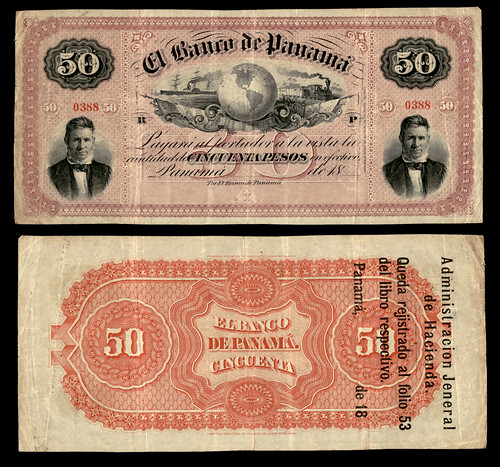
Colombia
Banco de Panama
S725 50 Pesos 18xx (ca. 1869)
Highest denomination; a sensational type from this dynamic series with LOW SERIAL NUMBER #388. Planas at left and right, steamship, globe, and steam passenger train. Without signatures. PMG terms this "VF 30"; the better of only two on the population report (with the other example the next lot and only two serial numbers away!). The only other time we offered this type was eight years ago in Memphis when it hammered for 22,000.
A rare and interesting note. -Editor
To read the complete lot description, see:
Banco de Panama
(http://www.lynknight.com/items/1158183)
Lot 81408: Ecuador Banco de Circulacion 5 Pesos
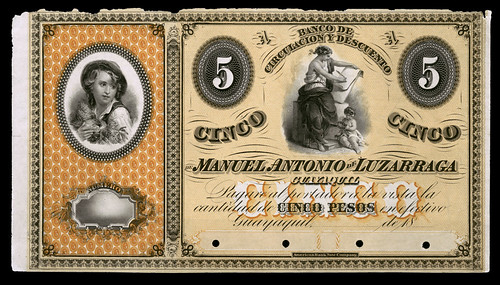
Ecuador
Banco de Circulacion y Descuento de Manuel Antonio de Luzarraga
S114p 5 Pesos 186x
Punch cancelled; without signatures. Girl, seated woman with tablet and child ("History"). PMG terms this "AU 50 edge damage"; the only example on the population report. Scarce in any form.
Unusual two-part layout; pretty colors. -Editor
To read the complete lot description, see:
Banco de Circulacion y Descuento de Manuel Antonio de Luzarraga
(http://www.lynknight.com/items/1158375)
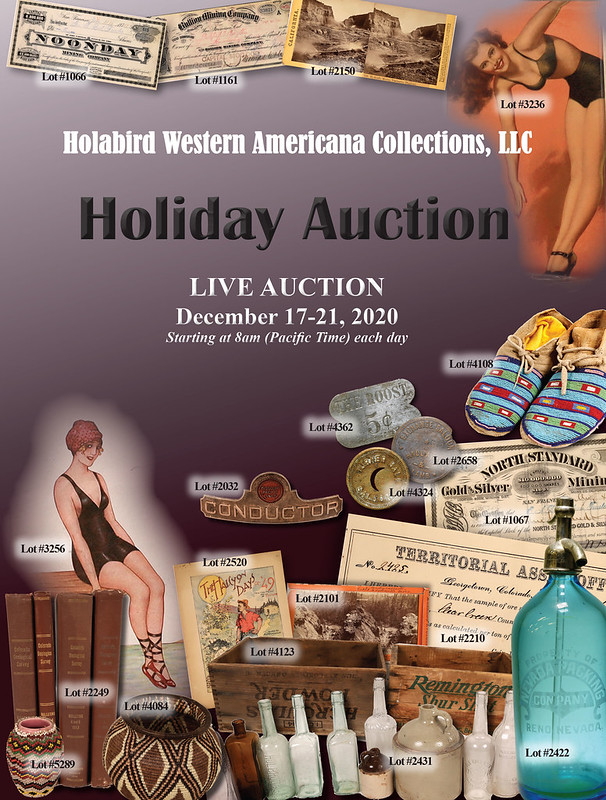
ARCHIVES INTERNATIONAL AUCTION 63 SELECTIONS
Here's a selection of lots that caught my eye in the Archives International Auctions sale closing December 9-10, 2020. Some really interesting items. -Editor
Lot 15: 1878 Armenian Turkey Scrip Note
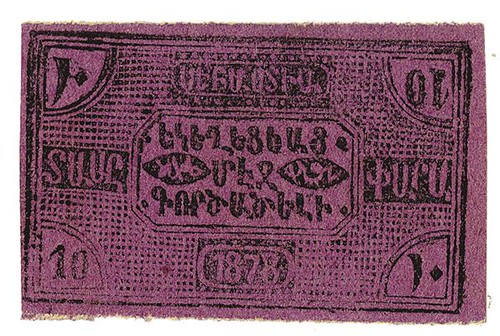
Armenian Turkey, 1878, 10 Para, P-Unlisted, Black on purple undertint. 2.5 x 1.5 inches. Rare.
If you think world banknotes are rare, try collecting private scrip. Great item. -Editor
To read the complete lot description, see:
Armenian Turkey - Sebastia, 1878, Issued Scrip Note.
(https://auction.archivesinternational.com/Armenian-Turkey-Sebastia-1878-Issued-Scrip-Note_i39175874)
Lot 104: 1928 Jewish People's Bank Bill
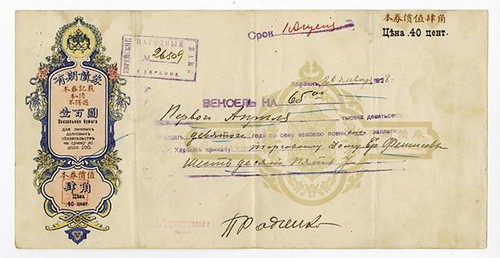
Harbin, China, 1928, $65 with Revenue stamp duty of 40cts, dark blue and light orange on left counterfoil, VF condition. Rare Harbin Fiscal document.
A little Googling found some background on this incongruous community. The Jewish Bank was founded in 1923. -Editor
The modern development of Harbin began at the close of the 19th century, with the beginning of the Russian penetration of Manchuria. When Russia was granted the concession to build the Chinese Eastern Railway under the Russo-Manchurian treaty of 1898, Harbin became its administrative center with a 30-mi. (50 km.)-wide zone along the railway. In the same year, a number of Russian Jewish families went to Harbin with the official consent of the czarist government, which was interested in speedily populating the area, and which, consequently, granted them a better status than that of the Jews in Russia. Among the first Jews were F.I. Rif, the brothers Samsonovich, and E.I. Dobisov. Along with other minority groups (such as Karaites), the Jews were granted plots of land on the outskirts of the town. Not being allowed to work directly on the railway, they were active as shopkeepers and contractors.
By 1903 a self-administered Jewish community existed in Harbin, numbering 500 Jews. After the Russo-Japanese War of 1905, many demobilized Jewish soldiers settled in Harbin, followed by refugees from the 1905–07 pogroms. By 1908 there were 8,000 Jews in the city, and a central synagogue was built in 1909. Several institutions came into being within the community, including clubs, a home for the aged, and a hospital providing care for all other nationalities as well.
For more information, see:
Harbin, China
(https://www.jewishvirtuallibrary.org/harbin)
The Jews of Harbin, China
(https://www.bh.org.il/jews-harbin/)
To read the complete lot description, see:
Jewish People's (or National) Bank in Harbin, 1928 Issued Bill of Exchange With Revenue Imprint.
(https://auction.archivesinternational.com/Jewish-People-s-or-National-Bank-in-Harbin-1928-Issued-Bill-of-Exchange-With-Revenue-Imprint_i39175963)
Lot 207: 1914 Sparkasse Sterkrade Notgeld
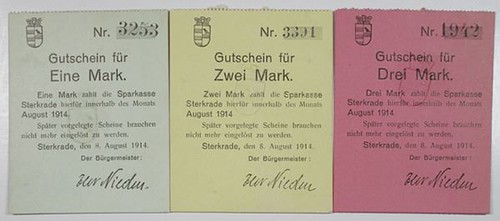
Germany. 1914. Sterkrade Saving Bank, K0380-b, Lot includes a trio of uniface 1, 2, and 4 Mark Notgeld, with Coat of Arms validation handstamp and signatures. About to Choice Unc. (3)
Plain, low-denomination notes from early in the war, likely intended for circulation, not collectors. -Editor
To read the complete lot description, see:
Sterkrade. Sparkasse Sterkrade, 1914. Lot of 3 Issued Notgeld Emergency Scrip Notes.
(https://auction.archivesinternational.com/Sterkrade-Sparkasse-Sterkrade-1914-Lot-of-3-Issued-Notgeld-Emergency-Scrip-Notes_i39176066)
Lot 324: Mexico 1000 Pesos Specimen Note
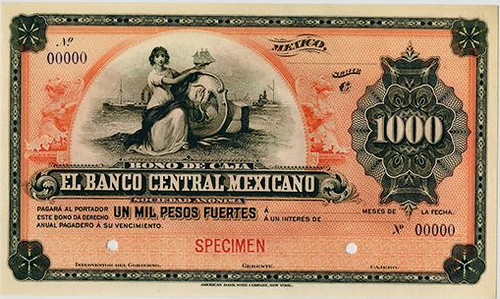
Mexico. Specimen 1000 Pesos Bono de Caja, P-Unlisted, M205s, s/n 00000, PMG graded Gem Uncirculated 65 EPQ, ABNC.
Great specimen note. Nice colors. -Editor
To read the complete lot description, see:
Banco Central Mexicano. ND(1908). Specimen Circulating Bond.
(https://auction.archivesinternational.com/Banco-Central-Mexicano-ND-1908-Specimen-Circulating-Bond_i39176183)
Lot 341: Joh Enschede Banknote Advertising Note
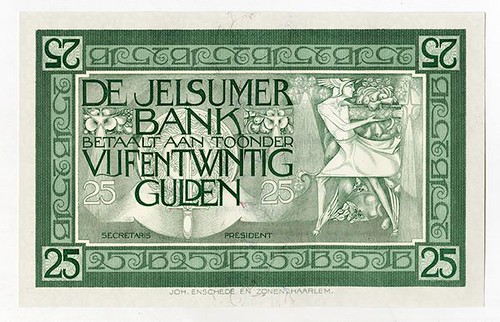
Netherlands, 25 Gulden, Printer Joh. Enschede En Zonen, Haarlem, Netherlands. P-Unlisted, Dark gray-green, turquoise green and m/c with an allegorical Art Deco figure on the right with ornate title on left, back has list of all of the products of the company on the back in English, French and Dutch. Choice to Gem Uncirculated or better. Extremely attractive and rare advertising note.
Great item. -Editor
To read the complete lot description, see:
De Jelsumer Bank, ND (ca.1920-30's) Joh. Enschede Banknote Look-a-like Advertising Note.
(https://auction.archivesinternational.com/De-Jelsumer-Bank-ND-ca-1920-30-s-Joh-Enschede-Banknote-Look-a-like-Advertising-Note_i39176200)
Lot 554: c1995 ABNCo Vignette Sample Book
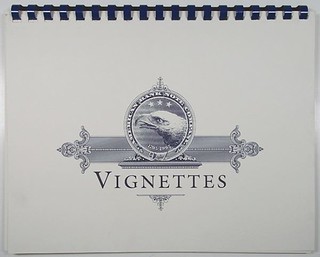
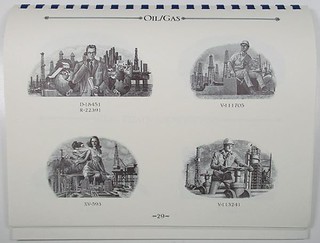
New York, 11 x 9 inch, 40 page book of multiple vignettes by topics with reference underprints by the American Bank Note Company. Table of Contents: Agriculture, Allegory-Male/Female, Allegorical Globes/Maps, Arts, Communication, Education, Energy, Family, Finance/Banking, Industry/Manufacturing. Lumber/Paper, Oil/Gas, Real Estate/Architecture, Science/Medical, Statue-Monuments, and Transportation. This book would have been utilized during the vignette selection by clients for the production of stocks, bonds, banknotes, etc. and highlights the product offerings of ABNC. VF, Bound in a spiral book. Like new.
Nice item for the bibliophile and student of banknote history. -Editor
To read the complete lot description, see:
American Bank Note Company "Vignettes" ca.1995 Litho Vignette Sample Book
(https://auction.archivesinternational.com/American-Bank-Note-Company-Vignettes-ca-1995-Litho-Vignette-Sample-Book_i39176413)
Lot 566: Franklin Bank Note Co. Advertising sign
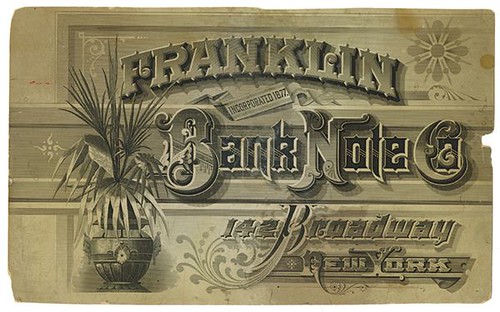
New York, NY. ND (Ca.1870-80's), 12 x 7.5 inches. Black on light beige paper, Ornate sign, some staining and rough edges with chips out of the right. Rare and attractive Security Printer sign. Franklin BNC.
Cool item. -Editor
To read the complete lot description, see:
Franklin Bank Note Co. - 142 Broadway, New York Advertising sign on thin cardboard.
(https://auction.archivesinternational.com/Franklin-Bank-Note-Co-142-Broadway-New-York-Advertising-sign-on-thin-cardboard_i39176425)
Lot 677: 1936 Ohio Communist Party 1936 Certificate
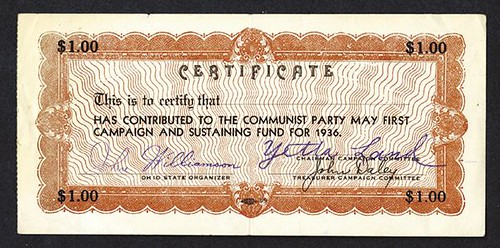
Ohio. $1.00 certificate for contribution to the May First Campaign Sustaining Fund for 1936. Stamped signatures of Ohio State Organizer, Campaign Committee Chairman and printed signature of Campaign treasurer. Not filled in. Very Fine, center fold.
Interesting. I'd never seen or heard of these. -Editor
To read the complete lot description, see:
Ohio Communist Party 1936 Contribution Certificate
(https://auction.archivesinternational.com/Ohio-Communist-Party-1936-Contribution-Certificate_i39176536)

STACKS BOWERS DECEMBER 2020 AUCTION SELECTIONS
Here's a selection of gold lots that caught my eye in the Stack's Bowers Galleries sales closing December 17, 18 & 21, 2020. -Editor
Lot 1450: 1850 Mormon $5
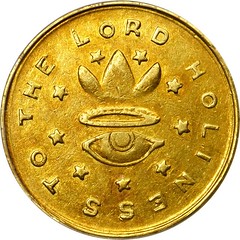
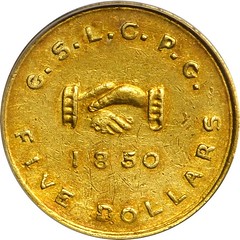
1850 Mormon $5. K-5. Rarity-5+. AU-55 (PCGS). CAC--Gold Label. OGH.
Bordering on Mint State, this is an outstanding example of the Mormon $5 from the second year, 1850. Attractively original, both sides exhibit iridescent pinkish-rose highlights to a base of warm honey-olive patina. The overall detail is exceptional, with the strike very well executed for a territorial gold coin produced under the rustic conditions that prevailed at the Mormon's Deseret facility. Even the most intricate design elements are at least bold, and most features are razor sharp to full. Rarely do Mormon gold coins of any denomination or date retain even faint traces of original luster, yet here there is ample evidence of a satiny finish. Wispy handling marks are not out of place on a lightly circulated Mormon gold coin. The appearance is remarkably smooth. As lustrous, sharp and attractive as one could expect in any Mormon gold coin, this is an incredible example of the issue that is sure to sell for a strong premium to a discerning collector.
The Kagin-5 variety is the only 1850-dated issue in the Mormon gold series, and the last produced using California gold. This issue uses a similar design to that seen on the 1849-dated Mormon coins, although the miter above the all-seeing eye has been replaced by a crown and halo, and the clasped hands are shaped differently and feature more intricate detail. Rarer than the 1849 Mormon $5, and typically offered no finer than the lowest reaches of AU (when available at all), the 1850 Mormon $5 is a tremendous condition rarity when found with the superior quality and strong eye appeal that define the Larry H. Miller specimen.
Marvelous example of Mormon gold. -Editor
To read the complete lot description, see:
1850 Mormon $5. K-5. Rarity-5+. AU-55 (PCGS). CAC--Gold Label. OGH.
(https://auctions.stacksbowers.com/lots/view/3-P9C9Y/1850-mormon-5-k-5-rarity-5-au-55-pcgs-cac-gold-label-ogh)
Lot 2027: Gold Dollar Love Token Bracelet
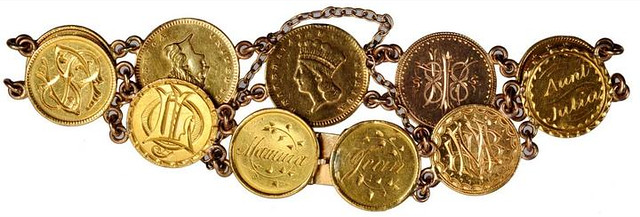
Love Token Bracelet made from (10) Gold Dollars.
7 inches. 18.55 grams. Fashioned from (8) Type 1 gold dollars; (2) Type 3 gold dollars that are .916 fine and an additional 14 mm unmarked gold disk that tests as 14k, has a reeded edge and is engraved on both sides. The clasp is functional and secure and a safety chain is also present. Only one date is noted, 1850, the other pieces are all engraved on the reverse so no dates are seen. Engravings include: MAMMA; JEAN; AUNT JULIA; and assorted monograms. Of note, the 14mm gold disk is heavily scratched on one side in what appears to be a test for gold purity. The bracelet is unmarked and does not test as gold. A wholesome example of this art form.
Provenance: From the Estate of Ruth Bauer.
Neat item. There are a couple other gold dollar jewelry items in the sale. -Editor
To read the complete lot description, see:
Love Token Bracelet made from (10) Gold Dollars.
(https://auctions.stacksbowers.com/lots/view/3-PDOF8/love-token-bracelet-made-from-10-gold-dollars)
Lot 2344: 1885 Proof Gold Dollar
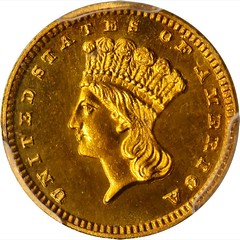
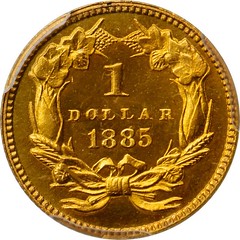
1885 Gold Dollar. JD-1. Rarity-4. Proof-66 Deep Cameo (PCGS). CAC.
Breathtakingly beautiful surfaces are silky smooth in texture with vivid reddish-orange patina. Reflective fields exhibit a subtle "orange peel" texture when observed with the aid of a loupe, and they form a splendid backdrop to fully impressed, satin-textured devices. Expertly preserved with eye appeal to spare, this delightful premium Gem Proof will please even the most discerning gold enthusiast.
The United States Mint in Philadelphia produced 1,105 Proof gold dollars in 1885. Writing in the excellent reference United States Proof Coins, Volume IV: Gold, Part I (2018), John W. Dannreuther states that 30 coins were delivered on January 17 for inclusion in complete Proof sets, followed by additional deliveries of 218, 106, 111 and 640 specimens before year's end. The author has identified two varieties for this issue using two obverse dies and one reverse die. The two die pairings are of equal rarity in numismatic circles with 100 to 150 coins believed extant for each. This puts the total surviving population of this issue at no more than 300 coins, the typical example encountered in today's market with lower quality and far less eye appeal than offered here. A phenomenal coin worthy of the strongest bids.
Nice example of a Proof gold rarity. -Editor
To read the complete lot description, see:
1885 Gold Dollar. JD-1. Rarity-4. Proof-66 Deep Cameo (PCGS). CAC.
(https://auctions.stacksbowers.com/lots/view/3-PDNBI/1885-gold-dollar-jd-1-rarity-4-proof-66-deep-cameo-pcgs-cac)
Lot 2346: 1842-O Quarter Eagle
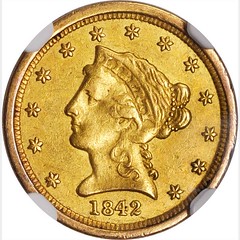
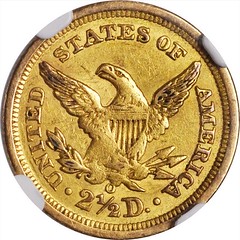
1842-O Liberty Head Quarter Eagle. Winter-1, the only known dies. AU-55 (NGC).
Warmly patinated in honey-gold, this piece is softly struck in the centers, yet considerably sharper toward the borders. The third rarest New Orleans Mint quarter eagle issue (per Doug Winter, 2020), the 1842-O has an extant population of fewer than 200 coins from a mintage of 19,800 pieces. This is a conditionally scarce survivor at the AU-55 level that would justice to an advanced Southern gold cabinet.
Great branch mint gold rarity. -Editor
To read the complete lot description, see:
1842-O Liberty Head Quarter Eagle. Winter-1, the only known dies. AU-55 (NGC).
(https://auctions.stacksbowers.com/lots/view/3-PDJRW/1842-o-liberty-head-quarter-eagle-winter-1-the-only-known-dies-au-55-ngc)
Lot 2376: 1810 Half Eagle
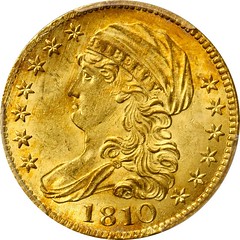
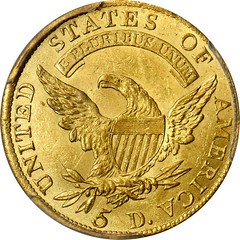
1810 Capped Bust Left Half Eagle. BD-4. Rarity-2. Large Date, Large 5. MS-64+ (PCGS). CAC.
A vivid and attractive condition rarity to represent this otherwise relatively obtainable die pairing in the Capped Bust Left half eagle series. This coin is well struck with most design elements sharply to fully rendered, though a few faint adjustment marks (as made) can be detected at the center of Liberty's portrait. Bright yellow-gold luster throughout with faint accents of deeper reddish-rose iridescence on the obverse that further enhance the eye appeal. A significant and fleeting bidding opportunity for the collector seeking a high grade example, as this variety is seldom offer above the basal MS-64 level. BD Die State a/a.
The four different die pairings used for the 1810 half eagles have been listed separately in the Red Book thanks to the readily discernible differences between the date and denomination logotypes. Only two of the four, BD-1 (Small Date, Tall 5) and BD-4 (Large Date, Large 5), as here, are regularly available to collectors. All told, 100,287 half eagles were struck from these die pairs, at least three-quarters of which were coined using the BD-4 marriage. Somewhere between 500 and 750 specimens are believed to reside in numismatic holdings, helping to make this one of the most popular type candidates for the entire series. In fact, its relative availability has made the 1810 BD-4 half eagle among the most popular of all the early U.S. gold varieties across all denominations. Sure to see spirited bidding.
Wow. A gorgeous early U.S. gold piece. -Editor
To read the complete lot description, see:
1810 Capped Bust Left Half Eagle. BD-4. Rarity-2. Large Date, Large 5. MS-64+ (PCGS). CAC.
(https://auctions.stacksbowers.com/lots/view/3-PDI3K/1810-capped-bust-left-half-eagle-bd-4-rarity-2-large-date-large-5-ms-64-pcgs-cac)
Lot 2445: Saint-Gaudens High Relief Double Eagle
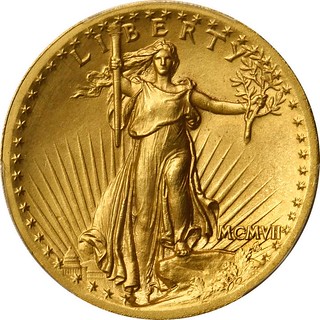
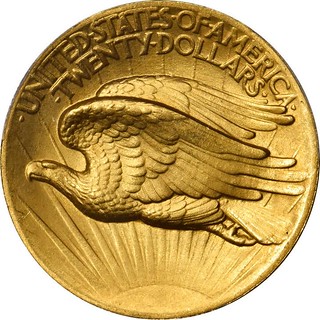
MCMVII (1907) Saint-Gaudens Double Eagle. High Relief. Wire Rim. Unc Details--Filed Rims (PCGS).
Worthy of a close look, and also strong bids, this is an exceptionally attractive High Relief double eagle in a "details" holder. The in hand appearance is smooth and lustrous to suggest Choice Mint State quality. Softly frosted in texture, both sides are further enhanced by handsome rose-orange patina. Evidence for the PCGS qualifier is trivial and easily overlooked, the filing light and generally confined to the obverse from 2 to 8 o'clock. A concentration of faint hairlines along the upper left obverse border is also noted for accuracy. Quite an attractive piece, and more than respectable as a Mint State example of this eagerly sought 20th century gold issue.
The ultimate U.S. gold coin. -Editor
To read the complete lot description, see:
MCMVII (1907) Saint-Gaudens Double Eagle. High Relief. Wire Rim. Unc Details--Filed Rims (PCGS).
(https://auctions.stacksbowers.com/lots/view/3-PDL90/mcmvii-1907-saint-gaudens-double-eagle-high-relief-wire-rim-unc-details-filed-rims-pcgs)
Lot 2517: 1915-S Panama-Pacific Exposition $50 Octagonal
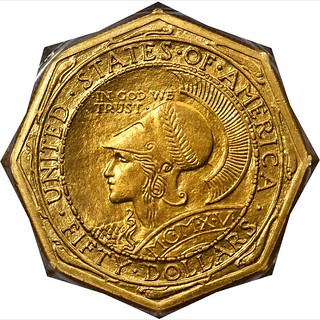
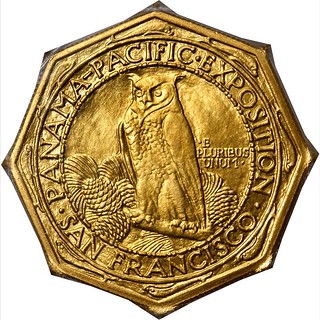
1915-S Panama-Pacific Exposition $50. Octagonal. MS-63 (PCGS).
This is a handsome piece, boldly struck with a blend of soft mint luster and vivid golden-rose patina. The overall appearance is superior for the assigned grade and, indeed, both sides are generally free from the distracting marks that are often so prevalent on examples of this conditionally challenging type. Strong eye appeal further enhances this coin's desirability for advanced collectors.
One of five issues struck in association with the Panama-Pacific International Exposition celebrating the opening of the Panama Canal, the Octagonal variant of the $50 gold shares the same basic design as its Round counterpart. Both were designed by Robert I. Aitken, the obverse depicting Minerva, goddess of wisdom, skill, contemplation, spinning, weaving, agriculture, and horticulture. A helmet is pushed back over the top of her head, while at her shoulder is the top of a shield inscribed with the date, MCMXV (1915), in Roman numerals. The motto IN GOD WE TRUST is in the upper left field, the legend UNITED STATES OF AMERICA lines the upper border, and the denomination FIFTY DOLLARS is below. Aitken's reverse features Minerva's sacred owl perched on a branch of Western pine, complete with large cones and needles. The Latin motto E PLURIBUS UNUM is in the right field, while the inscription PANAMA-PACIFIC EXPOSITION / SAN FRANCISCO encircles the border. The Octagonal variant, represented here, includes an extra outer border on both sides, each with eight dolphins that symbolize the uninterrupted waterway created by the opening of the Panama Canal.
The San Francisco Mint struck 1,500 examples of each variant of Panama-Pacific $50 for sale at the Exposition. Due to their different shape and the addition of the symbolic dolphin border, the Octagonal pieces proved more popular with contemporary buyers, resulting in a greater distribution than the $50 Round. In truth, sales for both were disappointing, the original asking price of $100/coin proving too steep for most contemporary Americans. Attempts to increase sales by discounting the price of the $50s when offered as part of sets with the smaller denomination Panama-Pacific coins did little to improve the situation, and in the end most examples of both varieties were melted as unsold. The distribution for the Octagonal proved to be just 645 pieces, greater than that of 483 coins for its Round counterpart, but still a small total that explains the scarcity of survivors in today's market. Eagerly sought in all grades, and understandably so, we anticipate keen bidder interest in this pleasing MS-63 example.
Classic U.S. rarity. -Editor
To read the complete lot description, see:
1915-S Panama-Pacific Exposition $50. Octagonal. MS-63 (PCGS).
(https://auctions.stacksbowers.com/lots/view/3-PDI2B/1915-s-panama-pacific-exposition-50-octagonal-ms-63-pcgs)
Lot 2521: 1926 Sesquicentennial Quarter Eagle
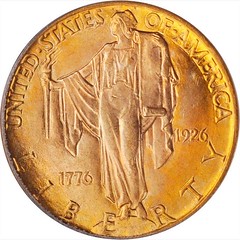

1926 Sesquicentennial of American Independence Quarter Eagle. MS-65 (PCGS).
I don't see these very often. Nice coins. -Editor
To read the complete lot description, see:
1926 Sesquicentennial of American Independence Quarter Eagle. MS-65 (PCGS).
(https://auctions.stacksbowers.com/lots/view/3-PDKX1/1926-sesquicentennial-of-american-independence-quarter-eagle-ms-65-pcgs)
THE BOOK BAZARRE
ROMAN SILVER COINS FOUND IN SERBIA
The excavation of a Roman legion's headquarters in Serbia has yielded a find of 120 Roman silver coins. -Editor
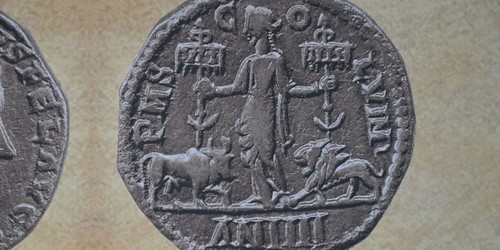
Buried under a Serbian cornfield close to a coalmine, the well-preserved remains of a Roman legion's headquarters are being excavated by archaeologists who say its rural location makes it unique.
Covering an estimated 3,500 square meters, the headquarters - or principium - belonged to the VII Claudia Legion. Its location was deduced in the spring during a survey.
The compound, which lies east of Belgrade and around one metre (3 ft) under the surface, had 40 rooms with heated walls, a treasury, a shrine, parade grounds and a fountain.
So far only a quarter has been explored, with excavations scheduled to resume next spring.
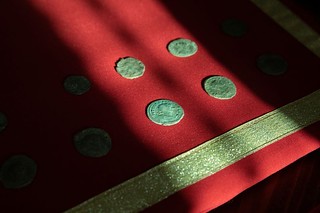 Inside one room, archaeologists found 120 silver coins that "must have been lost during an emergency" such as an invasion or a natural disaster, said the principium's lead archaeologist Nemanja Mrdjic.
Inside one room, archaeologists found 120 silver coins that "must have been lost during an emergency" such as an invasion or a natural disaster, said the principium's lead archaeologist Nemanja Mrdjic.
"The distribution of coins from a corner to the door, ... suggests they (coins) spilled while someone was fleeing."
The VII Claudia Legion was active between 2nd and 5th centuries AD, and its walled camp and principium were separated from the rest of Viminacium, which had its own fortifications.
Found via The Explorator newsletter. To subscribe to Explorator, send a blank email message to: explorator+subscribe@groups.io. -Editor
To read the complete articles, see:
Buried under a Serbian cornfield, Roman military headquarters slowly sheds its secrets
(https://www.yahoo.com/news/buried-under-serbian-cornfield-roman-150737460.html)
Archaeologists find silver coins at Roman-era site in Serbia
(https://www.israelhayom.com/2020/11/26/archaeologists-find-silver-coins-at-roman-era-site-in-serbia/)
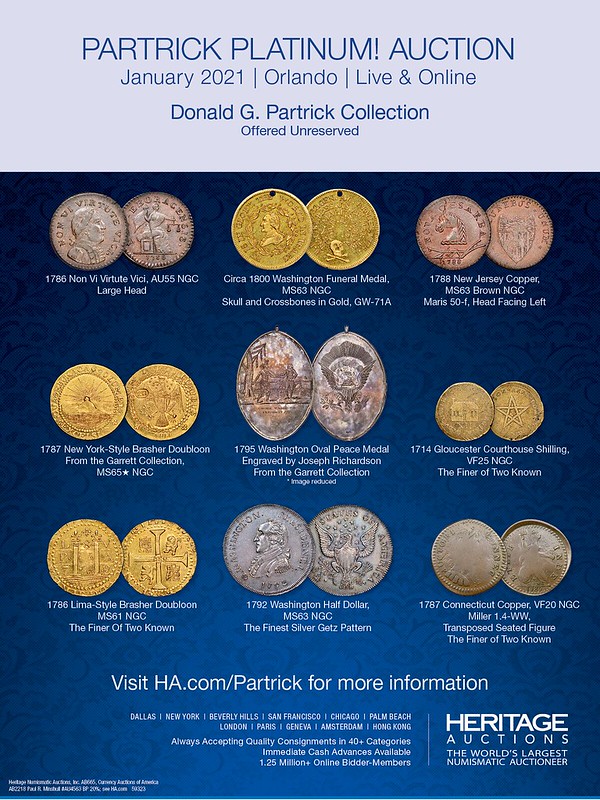
ADVENT COINS: A GAME OF THRONES
David Pickup submitted this article which is the first of a planned series of four for the season of advent, featuring coins or tokens with a link in some ways to the Christmas story. This first one is about the annunciation. Thanks! -Editor
Advent coins: A Game of Thrones
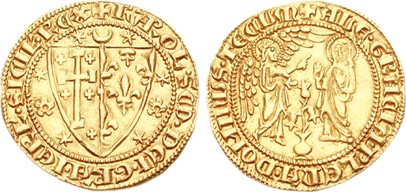
Attribution: Classical Numismatic Group, Inc. http://www.cngcoins.com
Advent is a season of preparing and looking to the future. Sometimes people use advent calendars which count down the days to Christmas. Over the next few Sundays I thought we would prepare and look forward through the medium of collecting. I will start with an angel telling Mary she was going to have a baby. You can see the expression on her face and the insistence on the part of the angel. This is a beautiful coin, with vivid figures brilliantly portrayed. The design makes perfect use of the space. Even the arms on the other side are well drawn in a field of stars and a moon.
These gold coins were issued by Charles I and his son Charles II of Anjou who was king of Naples and Sicily. The ones issued by his son are much rarer. They both also issued saluto d'argento which are silver coins with similar designs. The word salute means greeting in Italian and refers to the Angel's message to Mary which he begins by saying "Hail". The legend is AVE GRACIA PLENA DOMINUS TECUM which means Hail (you who are) full of grace, The Lord (is) with you.
I like the angel's chubby hands and his finger pointing at Mary. Both figures have halos and Mary has her full attention at his words. There is a lily between them which is both a symbol of purity and of the French royal house. The arms on the other side are those of the house of Anjou with the heraldic fleur de lys and the arms of the kingdom of Jerusalem. The engraver was Giovanni Fortino, 1266–1278.
Charles I 1226/1227 to 1285 was the founder of the second House of Anjou. He was also King of Sicily (1266–85) and Prince of Achaea (1278–85). In 1272, he was proclaimed King of Albania; and in 1277 he purchased a claim to the Kingdom of Jerusalem. Charles claimed the title of King of Jerusalem. He had purchased the claim from a lady called Mary of Antioch. Her mother was also Mary and she was married to John of Brienne, who had been King of Jerusalem. He seemed to collect titles as king in the way we collect coins! He certainly got around a bit. He went with the French King, Louis, during the Seventh Crusade to Egypt. He accepted the offer by the Pope to seize the Kingdom of Sicily from the Hohenstaufens. This kingdom included, in addition to the island of Sicily, southern Italy to north of Naples. As far as I know he did not go to Sicily or Jerusalem. Perhaps it was on his bucket list. His son, kept up the family tradition as King of Naples, Count of Provence and Forcalquier (1285–1309), Prince of Achaea (1285–1289), and Count of Anjou and Maine (1285–1290); he also styled himself King of Albania and claimed the Kingdom of Jerusalem from 1285.
The gold coin is a beautiful example of the designer's art. Charles may have wanted to highlight his religious beliefs or boost his status. Others seemed to think the design was a good one. In 1419 King Charles VI issued a French version and then in 1420 his son in law, Henry V issued gold salutes in Normandy. His son Henry VI issued salutes at ten mints in Northern France. These later gold salutes have the two figures standing behind shields which come up to the figures' waists. The two shields side by side together symbolise the political ambitions of the English throne over France.
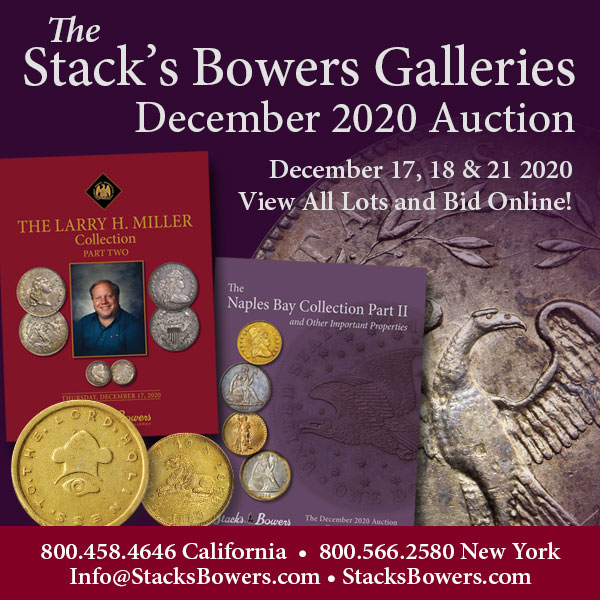
DIX NOONAN WEBB OFFERS RON KERRIDGE TOKENS
This Dix Noonan Webb press release highlights tokens offered in their upcoming December sale. -Editor
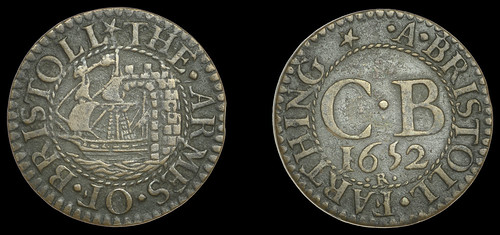
Lot 1053
Two of the most fascinating regional groups of tokens – from Sussex and Bristol - to be offered for sale in the past 50 years will be offered in a live/online auction of Coins, Tokens and Historical Medals on Tuesday & Wednesday, December 1 & 2, 2020 by International coins, medals, banknotes and jewellery specialists Dix Noonan Webb via their website www.dnw.co.uk.
The collection of tokens, Tickets and medals from Sussex were collected over many years by Ron Kerridge, who was born in 1938 in Southwick near Brighton in Sussex. He also lived in Southwick, when first married but then moved to Broadwater and had two children, Vanessa and John. Ron passed away suddenly on the 13 June 2013.
Ron had a deep thirst for knowledge and a great love of local history, particularly for the county of Sussex which he adored. He was a well-known and well-loved local historian with an MA in Regional History. A founder member of the Worthing Numismatic Society, he wrote or co-wrote books on the history of Lancing, Worthing, Broadwater and Ferring, and on the history of Worthing Football Club. He gave talks to local groups who were interested in the history of the surrounding areas. One of his friends described him as "a very talented person with a massive intellect, shrouded in modesty, and his focus on the 'job in hand' be it sport, work or writing a book never wavered".
Ron was an avid collector of palaeontological and archaeological artefacts and was a metal detectorist, but his greatest passion was numismatics. He was a volunteer at Worthing Museum, where he advised on their coin collection.
He had an outstanding collection of 'curious currency' or barter currencies from around the world, which are included within this catalogue. His collection included unique items such as beads, spears, knives and manillas (slave trade money). Over the years he painstakingly compiled collections of 17th, 18th and 19th century tokens, and his collection of Sussex 17th century tokens, numbering 131 pieces and begun in 1974, is one of the most complete ever formed. Many of the tokens are recorded in the 2009 self-published reference, The Tokens, Metallic Tickets, Checks and Passes of West Sussex, 1650-1950, by Ron and his colleague Rob de Ruiter. Together the two friends combined their talents, knowledge and interests to produce an original in- depth study, invaluable to collectors, metal detectorists, museum curators, family and local historians and all those interested in the social and local history of West Sussex. Ron's collection of Sussex-related medals encompasses 350 pieces, even including a Worthing High School medal awarded for Pillow Fighting in 1927 as part of a group of 29 medals which is estimated at £80-100 [Lot 1184] and his own Sussex Sunday Football League medal from the 1960-1 season is part of a group of 10 medals that carry an estimate of £50-80 [Lot 1177].
As Peter Preston-Morley, Head of Coin Department at Dix Noonan Webb, commented: "Ron had a keen eye for any Sussex-related tokens and medals, and because he was an active collector for so long, he was able to amass a vast group by county standards. He befriended everyone likely to come across pieces of interest to him, from metal detectorists and dealers to academics and museum curators. Most of all, he derived great pleasure from researching his acquisitions."
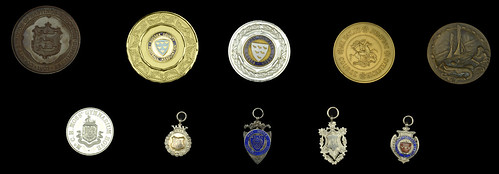
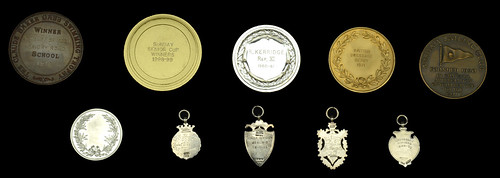
Lot 1177
The collection of 17th Century Tokens formed by the late Robert Thompson (Part 1) included examples from most counties of England, however it is the 19 lots of Bristol farthings which are the highlight. As Peter Preston-Morley notes: "Robert's essay on Bristol civic farthings, published in 1988, is as clear and concise as anything in print on tokens of that era." A notable highlight is a group of 13 examples dating from 1652 which carry an estimate of £100-150 [lot 1053].
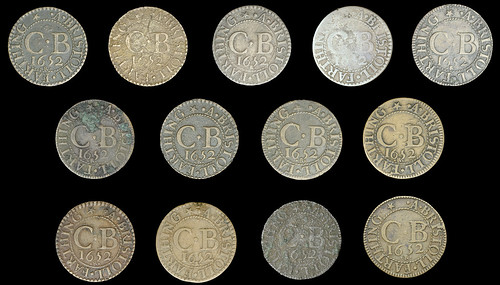
Lot 1053
For more information, see:
https://www.dnw.co.uk/
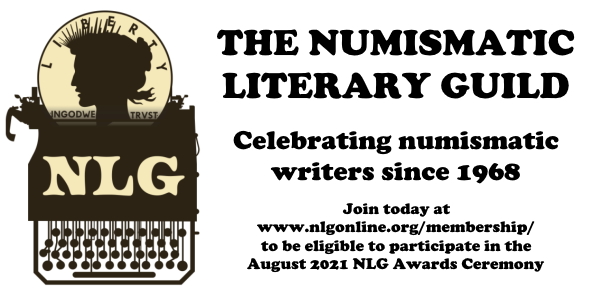
ROYAL SOCIETY MEMBER TICKET MEDALS OFFERED
Baldwin's of St. James also has an upcoming sale with many nice ancient and British coins. But a highlight for many will be their offering of silver members' tickets to the Royal Society of Edinburgh and the Royal Institution. Here's their press release. -Editor
An amazing group of silver members' tickets to the Royal Society of Edinburgh and the Royal Institution to be sold by Baldwin's of St. James's in London.
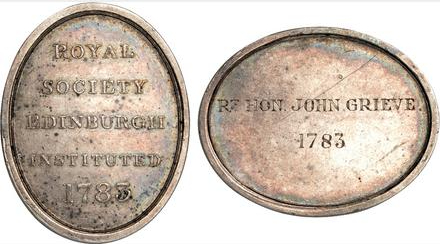
The recent report (13 June 2020, issue 2446) of Thomas Telford's silver membership ticket to the Royal Society of Edinburgh will serve to add interest to an exceptional group of seventeen named and three un-named tickets which are to be auctioned by Baldwin's of St. James's in London on 4th December 2020. The group has been discovered hidden amongst old stock that had been lingering in the basement vault of the coin dealers A. H. Baldwin & Sons. They were found together with a further group of seven named membership tickets to the Royal Institution in London. The whole group is quite unprecedented in recent auction history.
The Royal Society of Edinburgh was created in 1783 by Royal Charter for "the advancement of learning and useful knowledge" and started with a small group of just 178 founder members. Three founder member's tickets are amongst the group, each engraved with the member's name and the date of his election to Fellowship. The Rt Hon. John Grieve (d. 1803), Scottish Advocate and Statesman, was a Lord Provost of Edinburgh, a Commissioner of Excise and was highly influential in the "Mound Project" linking Edinburgh's Old and New Towns. The Rt Hon. Henry Dundas, 1st Viscount Melville and Baron Dunira (1742-1811), an advocate, Member of Parliament and statesman. Dundas was President of the Board of Control over the East India Company from 1793-1801.
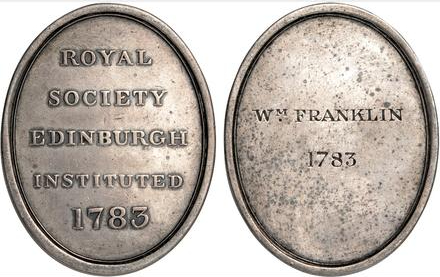
Then there is the Foreign Founder Member's ticket that belonged to Benjamin Franklin's illegitimate son, William (1730-1813). Unlike his father, his interests had been pro-British, he remained a steadfast Loyalist for which he was imprisoned. He went into exile in Britain in 1782, having lost his American estates, living in London until his death. Benjamin Franklin too, was elected an honorary founder member of the Society, though, sadly, his ticket is not amongst the group. William Franklin had travelled to Scotland and to Edinburgh in 1759 with his father (Benjamin Franklin was then living in London) and William was in Edinburgh again in 1783. The ticket to his father Benjamin sold at auction in New York in 2006 as part of the John J. Ford collection, for a staggering $26,000.
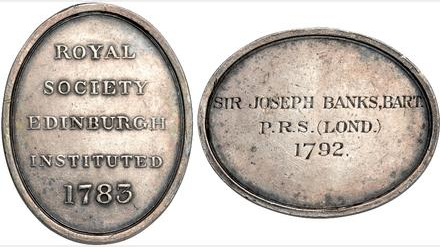
The highlight of the group has to be the highly important silver ticket or pass named to Sir Joseph Banks (1743-1820), the explorer, naturalist, botanist and great patron of the natural sciences. Banks was elected on 23 January, 1792, when he President of the Royal Society in London. The 37 x 29mm ticket is engraved on the reverse "SIR JOSEPH BANKS, BART. F.R.S. (LOND.) 1792". Also two of the Royal Institution tickets are named to Banks, "Rt. Hon. Sir Jos. Banks Bart. P.R.S. F.S.A." and "Rt. Hon. Sir Joseph Banks Bart. G.C.B. Pr.R.S." Any memorabilia associated with Joseph Banks is extremely rare in the market-place which has made it hard for the auctioneers to estimate the value but £5000-8000 has been placed on the Royal Society of Edinburgh ticket and £1000-1500 each on those of the Royal Institution.
Banks's election to the Royal Society in London had come a mere two weeks after his return from Constantine Phipps's (who knew Banks from his Eton school days) expedition on HMS Niger, and over a decade before he and fellow botanist Daniel Solander, took part in Captain James Cook's first voyage to the Pacific (1768–1771), on HMS Endeavor. Banks had further Edinburgh connections having been elected a Fellow of The Royal College of Surgeons of Edinburgh.
The remaining two silver tickets of the Royal Society of Edinburgh are named to Henry Brougham (1742-1810) and Sir Henry Englefield (1752-1822).
The Royal Institution of Great Britain (located at 21 Albermarle Street, London), was founded in March 1799 at a meeting at the home of Sir Joseph Banks in Soho Square, London. The Institution received its Royal Charter in 1800 then in 1810 it was converted, by an Act of Parliament, from a private organisation owned by a small number of Proprietors to a public institution.
The circular silver member's admission tickets in the auction all carry the date 1819 and each is engraved with the owner's name and titles. Banks's two tickets have already been mentioned, but another leading figure in the history of the Institution was Sir Humphry Davy (1778-1829). Davy moved to London in 1801 to work for them as Assistant Lecturer, being promoted to Professor of Chemistry the following year. Today he might be remembered for the miner's safety lamp (1815), but his achievements at the Institution makes a formidable list.
As with the Royal Society of Edinburgh, the Royal Institution has a ticket of American interest, named to William Penn's grandson, the politician and writer John Penn (1760–1834) who, on the death of his father in 1775, became the Chief Proprietor of the Province of Pennsylvania with hereditary governorship. He moved to America but following the American Revolution and after the Pennsylvania government paid him some £97,500 as his portion of the compensation due for the proprietorship, he returned to live in England.
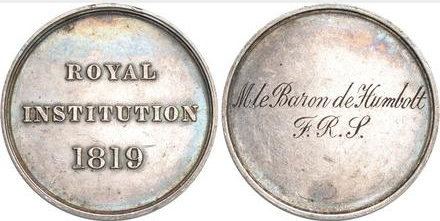
The sale also includes a ticket is named to the German naturalist and traveller, Alexander von Humboldt (1769-1859), whilst another is named to Alexander Davison (1750-1829), Admiral Lord Nelson's prize-agent.
What an amazing find! Great connection to some of the leading figures of The Enlightenment. Member's tickets are the ultimate personal numismatic connection to great historical figures. -Editor
For more information, see:
https://bsjauctions.com/
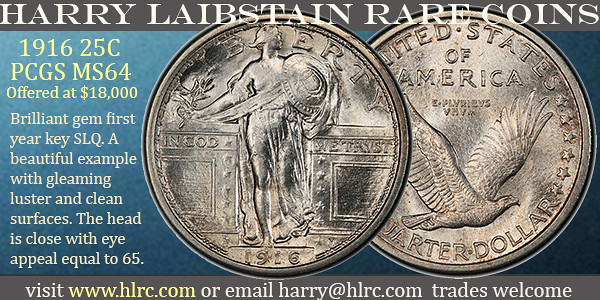
GARY ALLISS GOLFING MEDAL COLLECTION OFFERED
Back to Dix Noon Webb for a moment, they're offering an interesting group of modern golfing medals. Here's the press release. -Editor
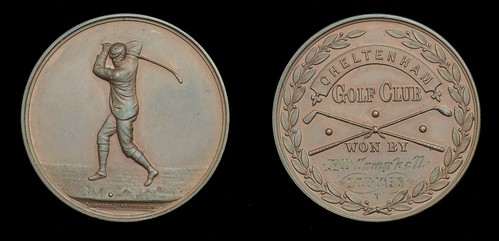
Lot 1365
A group of Golfing medals from the Collection of Gary Alliss relating to golf courses around the world will be offered in a live/online auction of Coins, Tokens and Historical Medals on Tuesday & Wednesday, December 1 & 2, 2020 by International coins, medals, banknotes and jewellery specialists Dix Noonan Webb via their website www.dnw.co.uk.
A member of one of the most famous golfing familes, Gary Alliss is a golf professional and the third generation of golfing Allisses! He has been a coin collector for almost 60 years - since he was seven years old. He had a substantial collection of coins of the reign of Stephen, which he sold about 15 years ago.
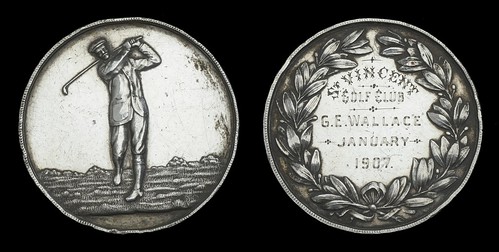
Lot 1371
As he explained; "I decided to start buying golf medals in the 1990s, just because I am a golf professional and both my father and grandfather were professionals and both very famous!! What interested me about the golf medals was either the golf club they were from, such as The Royal Cornwall Golf Club, it ceased c1960 and as a pro I was based at Trevose GCC Cornwall for many years. Then others were from overseas clubs, the first course in Croatia for example and Cape Verde."
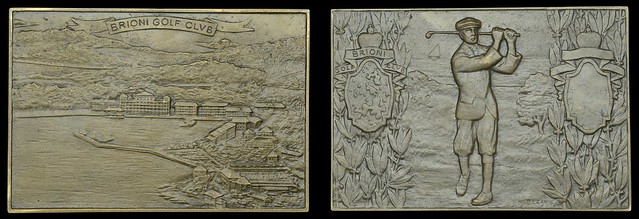
Lot 1372
Gary also bought medals as they fascinated him – such as a very rare early silver award medal for Cape Verde Islands, St Vincent Golf Club, dating from 1907, which is estimated at £40-60, and a large cast bronze plaque of an aerial view of Brioni Golf Club at Fazana in Croatia, which opened in 1922, and was said at the time to be the largest golf course on mainland Europe, is expected to fetch £120-150.
Gary Alliss is a golf professional. He was professional at Trevose GCC for 30 years then head professional at The Belfry. He is a Master Professional – known as a coach than player as he has coached young golfers from beginners to international stardom. He captained the GB & I PGA cup teams v USA in 2007 & 2009 and is part of the Sky TV commentary team covering the Europro Golf Tour. He is selling the medals as he is now semi retired and recently downsized and doesn't have space to display the items.

DISNEY SECURITY'S UNOFFICIAL CHALLENGE COINS
This Gizmondo article takes a look at a number of unofficial Disney Security challenge coins that have been showing up in the market. -Editor
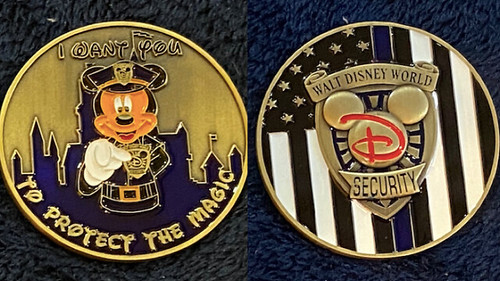
Challenge coins are small, commemorative medallions often distributed within a wide range of organizations as symbols of membership and camaraderie fostered through "challenges" in which people are required to show their coins on demand to prove that they're carrying them. There are varying rules on what happens if you're found without your coin depending on the group you're playing with. Most commonly, challenge coins have been associated with the military and its culture, which is at least part of why Disney currently has a sanctioned selection of them that a number of its park security personnel reportedly carry.
Speaking with Task & Purpose, a Walt Disney World representative explained that its official challenge coins are part of its efforts to embrace the traditions held dear by its "security departments and other areas where military veterans have come to work after their service." It's important to understand that challenge coins aren't exactly readily available to the general public, as they're meant to be special items that represent the bond between a select group of people—in this case, those working security for Disney.
There is nothing inherently wrong with challenge coins, and it makes a degree of sense that Disney would produce the coins for them to collect and trade, as collecting is a huge part of its brand already. What's somewhat concerning, though, are the number of unofficial challenge coins using characters like Mickey Mouse and the Punisher to not only associate the people holding them with Disney and Marvel at a glance, but also with a certain stance on policing.
It should be noted that none of the challenge coins pictured in this piece are part of Disney's official set, and all custom coins that staffers have made for use are subject to an internal review process should they include any of the company's intellectual property. We've reached out to Disney asking for comment about this piece and clarification on what their official coins look like, but did not hear back by time of publishing.
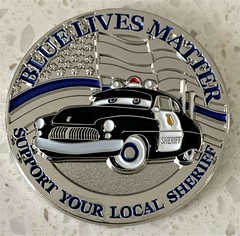 A casual search through eBay turns up more than a few challenge coins depicting Mickey Mouse as a cop, a fictional Department of Homeland security officer focused on magic, and a police car from Cars professing that "Blue Lives Matter."
A casual search through eBay turns up more than a few challenge coins depicting Mickey Mouse as a cop, a fictional Department of Homeland security officer focused on magic, and a police car from Cars professing that "Blue Lives Matter."
To read the complete article, see:
Disney Security's Unofficial Challenge Coins Are a Different Sort of Collector's Item
(https://io9.gizmodo.com/disney-securitys-unofficial-challenge-coins-are-a-diffe-1845750767)

RUSSIA MAY VARNISH BANKNOTES
Goznak is the Russian unit responsible for manufacturing security products including banknotes, coins, stamps, and identity cards. According to this article, they're considering varnishing certain banknotes to extend their life in circulation.
Found via News & Notes from the Society of Paper Money Collectors (Volume VI, Number 22, November 17, 2020).-Editor
Goznak is preparing to varnish all 100 ruble banknotes and is technically ready to cover with varnishing the entire range of low and medium denominations, up to 500 rubles inclusive, said the company's CEO Arkady Trachuk in an interview with RG.
He stressed that everything depends on the position of the Bank of Russia, both in terms of determining which denominations should be treated, and the timing and costs.
The head of Goznak spoke about the degree of danger of banknotes during a pandemic Earlier, by the decision of the Bank of Russia, a varnish coating was applied on a part of the circulation of one hundred-ruble banknotes, tested on banknotes with a face value of 200 rubles. This significantly extends the life of the banknotes. It is almost impossible to determine this coating by sight and touch. "Lacquered banknotes fully retain the properties of those antiseptic additives that we use in the manufacture of banknote paper for Russian banknotes," Trachuk said when asked whether a banknote with a coat of varnish from the point of view of the spread of infections is safer.
To read the complete article, see:
Russia – Protective coat considered for small denomination banknotes.
(https://mriguide.com/russia-protective-coat-considered-for-small-denomination-banknotes/)
ZIMBABWE DEALERS REPAIR WORN OUT DOLLARS
In the they-really-know-how-to-stretch-a-dollar department, this article describes how Zimbabwe currency dealers repair worn out dollar notes. -Editor
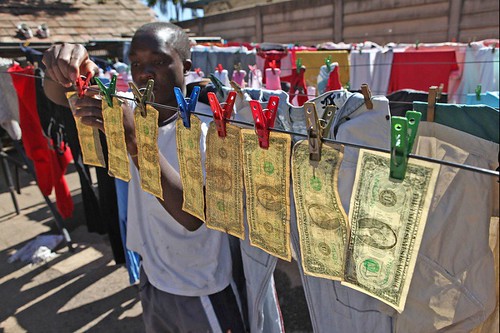
Traders in Zimbabwe have resorted to repairing old US dollar notes for desperate customers.
Fresh new US dollar currency is not coming into the Southern African nation. And so dealers buy the tattered notes and make profits off the black market.
"I don't care how torn it is, I take it. All I want to see is the serial number, the serial number should be visible on all the sides. Even if it's shredded by rats, I take it, I do this every day that's how I survive", currency dealer, Albert Marombe said.
Many shops reject it, but market traders will often, with some negotiation, accept the glue-patched notes.
"The problem that we are meeting here is over change, every time we are buying here they don't have enough change for US dollar. So it's either we are forced to get these coupons or we get something that can compensate the difference", Innocent Chirume, a shopper said.
"The main problem is that we do not have faith in our own currency, and so the Zimbabwe dollar that exist are now of such a low value we don't want to carry them around because you need a large quantity just to buy a loaf of bread", Robertson said.
The $1 notes are used by many people to buy their daily bread and other small purchases.
Having seen so many worn, tattered, and pinned together U.S. colonial-era banknotes, I imagine today's Zimbabwe provides a similar experience.
Also found via News & Notes from the Society of Paper Money Collectors (Volume VI, Number 22, November 17, 2020). -Editor
To read the complete article, see:
Zimbabwe currency dealers repair worn out dollar notes
(https://www.newzimbabwe.com/zimbabwe-currency-dealers-repair-worn-out-dollar-notes/)

LOCALIZED U.S. COIN SHORTAGES CONTINUE
This Newsweek article discusses the continuing localized coin shortages across the U.S. -Editor
"Brother, can you spare a dime?"
That question became famous in the Great Depression.
In 2020, with the pandemic raging, the answer could be, "Maybe, but they're hard to find."
Localized temporary scarcity of coins, known as "spot coin shortages," an unintended consequence of the economic lockdown intended to curb spread of the coronavirus, are again turning up in some regions of the nation. But the shortages aren't as severe as last summer's coin crunch, as more merchants and individuals recirculate pennies, nickels, dimes and quarters.
Steve Kenneally, senior vice president for payments at the American Bankers Association in Washington, said spot coin shortages have been reported in the Midwest and a few major cities, including Detroit, Philadelphia and Atlanta.
Individual retailers can sometimes run out of coins, but the current shortage doesn't appear to be chronic.
"I think we're far from where we were last summer," he told Newsweek. "There's concern, but it's not an issue yet. There are some hot spots, but things are much better."
Unlike last summer, he said stores in and around Washington haven't posted signs urging customers to use exact change. This is anecdotal, but suggests an adequate supply of coins.
He said coins valued at about $40 billion are in circulation.
"The (U.S) Mint can't out-produce the problem," Kenneally said. "We need to get the coins out there moving. More people need to find, spend, and make (bank) deposits to get coins back in circulation."
To read the complete article, see:
U.S. Coin Shortage, Like COVID-19, Depends on Your Location
(https://www.newsweek.com/us-coin-shortage-like-covid-19-depends-your-location-1550309)
WHO WILL MISS THE COINS WHEN THEY'RE GONE?
Robert Hoge, Tom Sheehan and Stu Levine passed along this New York Times article about the steady march to a cashless society. Thanks. -Editor
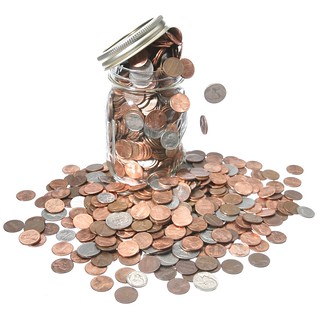 They gather unloved in jars and under cushions, unearthed only when laundry needs doing. They rattle in coat pockets, music to some ears and a nuisance to others. They sink into fountains and lurk in wells, a fortune in wishes but a nightmare to sort and count.
They gather unloved in jars and under cushions, unearthed only when laundry needs doing. They rattle in coat pockets, music to some ears and a nuisance to others. They sink into fountains and lurk in wells, a fortune in wishes but a nightmare to sort and count.
Coins are everywhere until they're nowhere, and at the moment they're hard to find. By upending normal habits, the pandemic has dropped them out of circulation and accelerated a trend toward cards, apps and other cashless payments that could eventually make coins obsolete.
China has plans for a digital currency, and the U.S. Federal Reserve is doing "research and experimentation." Facebook has a currency in the works, and Bitcoin's evangelists are still preaching. Millions of Americans are skipping right over coins by paying with their phones — or shopping on them.
"There's a battle for the future of money going on," said Alex Tapscott, a co-founder of the Blockchain Research Institute, a Canadian firm. Governments, banks, credit card companies and online communities are among the factions trying to change how people make payments, he said.
How the coronavirus sidelined coins
A funeral for cash has not yet been scheduled, but the pandemic has made it much easier to imagine a world without coins, and already reinvigorated the movement to get rid of pennies. For banks, credit card companies and some Bitcoin advocates, the demise of each unit of cash would be welcome news. For small businesses that rely on coins, it's a slow-rolling earthquake. For archaeologists and collectors, it's bittersweet at best and a tragedy at worst.
Convenience with a cost
While small businesses have had to adapt reluctantly to a cashless world, many tech firms, banks and credit card companies have pushed for one, said Jay Zagorsky, a professor at the Questrom School of Business at Boston University.
"The economy is bifurcating, sort of splitting in two parts, and there's one part that's taking a beating," he said.
The people saving pennies
Coins will always have defenders in curators and collectors like the 26,000 members of the American Numismatic Association. The group's education director, Rod Gillis, hopes they never stop circulating. "I would really hate for us to become a cashless society," he said. "I would hate for us to lose our historical perspective."
And coins have survived other inventions — paper bills, stock markets, E-ZPass — outlasting many of the monarchies, republics and empires they were made to hold together. Their value as artifacts is "wonderful," said Dr. Fleur Kemmers, an archaeologist at Goethe University Frankfurt. She called ancient coins "historic documents," passed down by people across centuries and continents as they haggled, hoarded and made their way through daily life. She said that in their design, material makeup and discovered locations, coins can reveal clues about culture, politics, religion, industry, trade and household life.
But Dr. Kemmers said that aside from their symbolism, she was "not that optimistic about the long-term future of coins." With one exception: "Commemorative coins might be something that will last."
To read the complete article, see:
Who Will Miss the Coins When They're Gone?
(https://www.nytimes.com/2020/11/24/business/coin-shortage.html)
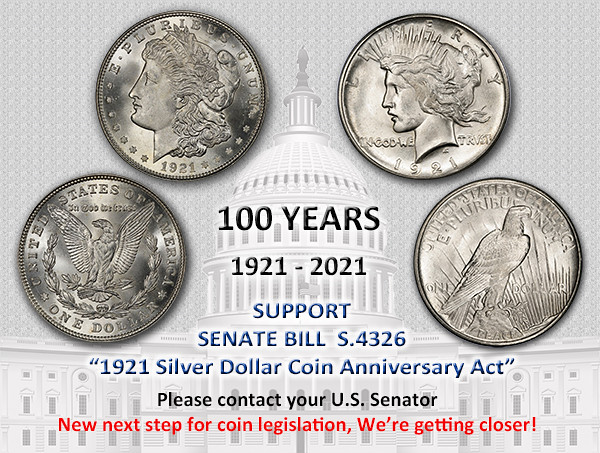
LOOSE CHANGE: NOVEMBER 29, 2020
Here are some additional items in the media this week that may be of interest. -Editor
Moneyed Street Names
Here's a curious discovery (or total coincidence): a study claims that homes are worth more when they're on streets with money-themed names. -Editor
When it comes to buying a home, most people focus on the location, size and style of a property.
However, savvy house hunters may want to factor in the street name if they are shopping on a budget.
New analysis from Invezz.com shows that houses with money-related street names often sell at a higher price.
It looked at around 1,000 road names across the UK and discovered that London streets with cash terms in their name sold for £272,000 more than others in that area.
In North London houses sold for more on Bank Lane (N11), Copper Close (N17), Gold Close (EN10), Pound Lane (NW10) and Silver Street (EN1, EN7 and EN9).
The same was true of houses in East London on Bank Street (E14), Copper Street (E20), Pound Close (EN9), Pound Lane, (RM16) and Rich Street (E14).
Do any of our readers live on or near streets/neighborhoods/towns with numismatic or money-themed names? I'll keep your response confidential if you like, but send in your entries and I'll compile a list. There may not be an Uncirculated Circle, but there is of course, a real Penny Lane. Dime Street? How about a Greenback Chase? Dollar Hollow (pronounced "Holler")? Currency Canyon? Banknote Bend? Bonus points for pictures of street signs. Have fun! -Editor
To read the complete article, see:
The curious detail in a London road name that could mean houses there are worth £272k more
(https://www.mylondon.news/news/property/curious-detail-london-road-name-19330743)
Disney World Donates Wishing Well Coins
That small change adds up. Disney World fished $20,000 worth of coins from its wishing wells to donate to charity. -Editor
Some $20,000 in coins that tourists tossed into Walt Disney World's wishing wells and fountains became a Thanksgiving gift for central Florida's largest homeless shelter.
"I am just so thankful, especially in light of everything that's going on in the world and everything Disney is going through," said Allison Krall, CEO of the Coalition for the Homeless of Central Florida, told the Orlando Sentinel. "We needed this so very much."
The coins were dropped in the iconic wishing well at Cinderella's Castle, along the waterways of the "It's a Small World" ride, and in fountains throughout the local parks.
Disney periodically collects, cleans and sorts the coins before donating the total to a Central Florida charity, the newspaper reported.
To read the complete article, see:
'So thankful': Disney World donates $20,000 in wishing well coins to homeless charity
(https://www.usatoday.com/story/travel/2020/11/28/disney-world-donates-20-000-wishing-well-coins-homeless-charity/6449441002/)
Prohibition-Era Whiskey in New York Home
Richard Miranda passed along this story of a surprising house find. It's non-numismatic, but we collectors enjoy stories of unusual and valuable discoveries. -Editor
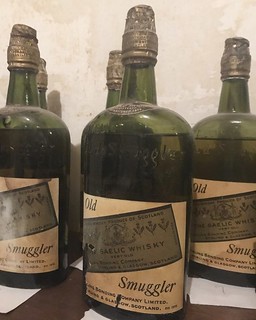 A New York couple didn't believe that their century-old home was built by a legendary bootlegger until they decided to undergo renovations last month.
A New York couple didn't believe that their century-old home was built by a legendary bootlegger until they decided to undergo renovations last month.
Nick Drummond and Patrick Bakker were shocked to discover that hiding in the walls and floorboards of their house in the village of Ames, about three hours away from New York City, was more than 66 bottles of smuggled Prohibition-era whiskey, according to CNN.
Drummond told CNN he was removing outside skirting along the bottom of the mudroom when a package fell out.
"I'm like what is that? I'm very confused," he told the outlet. "I'm looking and there's hay everywhere, there's paper, and glass ... I see another package and it's this whiskey bottle. I'm like holy crap. This is like a whiskey stash. And this is like, all of a sudden, the whole story of the bootlegger."
Drummond said he has done a lot of research on the man who built his home and found out that Humpfner was under numerous investigations and died a suspicious death.
The couple plans to keep one of the full bottles of whiskey to taste for themselves and sell the other full bottles, which are estimated to sell for $1,000 each, Drummond said.
To read the complete article, see:
Couple Finds More Than 66 Bottles of Prohibition-Era Whiskey in New York Home
(https://www.yahoo.com/entertainment/couple-finds-more-66-bottles-203021387.html)
How German Librarians Caught a Book Thief
To bibliophiles, book thieves are the lowest of all scum. Lower still are those who damage books to take valuable illustrations like maps. This article details how German librarians eventually caught a notoriously elusive map thief. -Editor
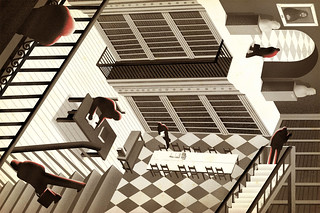 Müller and Roeder began combing through the volumes. Two of them, including a valuable Spanish geography tome, were unharmed. The third, Louis Renard's Atlas van Zeevaert en Koophandel door de geheule Weereldt, a sea-and-trade atlas from 1745, seemed fine at first glance—but then they looked closer.
Müller and Roeder began combing through the volumes. Two of them, including a valuable Spanish geography tome, were unharmed. The third, Louis Renard's Atlas van Zeevaert en Koophandel door de geheule Weereldt, a sea-and-trade atlas from 1745, seemed fine at first glance—but then they looked closer.
Schild had cut out nine maps, including Renard's rendering of the entire known world and intricate illustrations of southeast Asia and the Hudson Bay. He'd also cut out the appendix, which included the list of those maps. As if that weren't enough, he'd also taken a pencil and numbered the remaining maps in tiny writing on the upper right-hand corner, in the manner of a professional archivist. Only an attentive reader would notice what was missing.
"I was sitting there, and I could hardly breathe," Roeder recalls. "He was really a professional."
Roeder filed a report with the Oldenburg police. (She later estimated the damages at between $44,130 and $48,800.) At the recommendation of an acquaintance, she also scoured online auctions for maps that could have come from the Renard book. She compared sales photos with the distinctive coloring, size, paper yellowing, and wrinkles of the Oldenburg atlas, and emailed antiques dealers, asking about the provenance of the maps on sale.
By Easter, Roeder had narrowed her search down to two sellers. On a sunny day in early May, 2006, Roeder and her colleague Klaus-Peter Müller climbed into the Oldenburg Library's red VW Golf and drove off in search of the missing maps. "We felt like we were in a road movie," Roeder says.
To read the complete article, see:
How German Librarians Finally Caught an Elusive Book Thief
(https://www.atlasobscura.com/articles/how-german-librarians-caught-a-book-thief)
The Proposed Digital Euro
Kavan Ratnatunga passed along links to two European Central Bank articles relating to the proposed Digital Euro currency. Bitcoin fans would likely provide a very different "explainer" on its pros and cons. It will be interesting to see how these digital currency battles turn out. In the end I suspect we'll see a handful of parallel viable systems emerge, with and without central bank backing. -Editor
https://www.ecb.europa.eu/euro/html/digitaleuro.en.html
https://www.ecb.europa.eu/explainers/tell-me/html/what-is-bitcoin.en.html

QUERY: NUMISMATIC MASKS?
David Gladfelter writes:
"Have you seen any numismatic masks? Artistic, wacky, cornball, whatever – there must be some worth reporting on?"
Actually, I haven't seen any. Of course, like most people these days, I don't get out much. But this pandemic has been going on plenty long enough for enterprising marketers to manufacture masks with a numismatic theme. Are coin clubs making any?
I found some online (just in time to Christmas shop for our numismatic friends)! One shows a fantasy coin picturing George Floyd. Most of these manufacturers offer a wide selection of numismatic-themed designs. There's even a "Hugh McCullock Face Mask" with a Bureau of Engraving and Printing image. I suspect these are all made to order using stock photos. I doubt there are warehouse shelves stocked with dozens of different versions awaiting buyers. Each could be a unique or near-unique collectible someday. -Editor
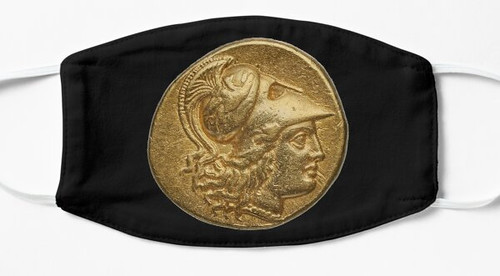
Redbubble Gold Coin Face Masks | Redbubble
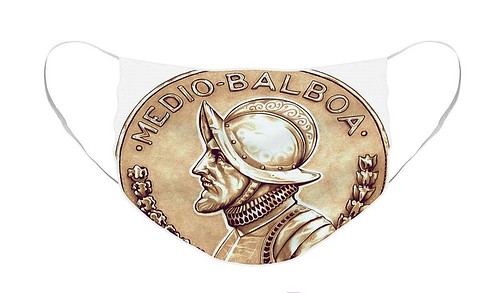
Bronze Balboa Face Mask
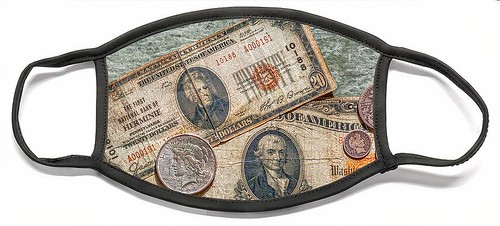
Paper Money and Silver Coins Face Mask
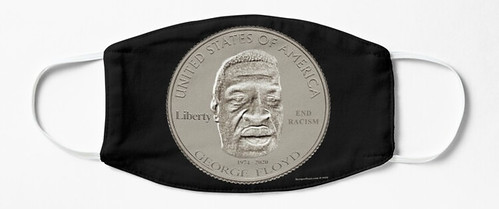
George Floyd Coin Design Mask
FEATURED WEB SITE: SRI LANKA BANKNOTES
This week's Featured Web Site is the Lakdiva BankNote Collection, Dr. Kavan Ratnatunga's web display of a personal collection of legally circulated colonial, and modern currency from Sri Lanka (Ceylon).
Lakdiva BankNotes hopes to documented over 500 Lankan BankNote Types and other Lankan Numismatic Paper items in over 300 web pages. Motivated by many reasons this long term project may take many years to complete. It is purely an attempt to put part of my Lankan heritage on the web, as much as I can afford to do so in both money and time. Significant contribution of Ceylon BankNotes or high resolution images to complete the site will be gratefully acknowledged.
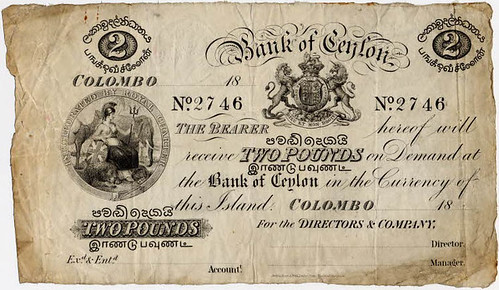
http://notes.lakdiva.org/

